New Locations Now Open

- Dr Gemma Nash

Taking a dog to Spain and back in 2024: Everything you need to know

Travelling with a dog to Spain can be a fun and enjoyable experience, but it's important to do your research and prepare in advance to ensure a smooth and stress-free journey, especially now the rules have changed following Brexit. In this guide, we'll go over the key steps to travel with dog from the UK to Spain (and back again), including vaccinations, travel documents and other treatments required.
This guide is frequently updated by our vets to ensure the advice we give is up to date. If you think that something is incorrect or out of date please do contact us so we can update our guide.
Please note: this guide is for pet dogs travelling to Spain from the UK. If you are planning on travelling to Spain from another county, or if you are taking dogs over to Spain for commercial reasons, different requirements may apply.
6 Steps to Travel with your Dog from the UK to Spain and Back
Book your dog in for a rabies vaccination at the vets
Arrange your travel to Spain
Obtain an Animal Health Certificate within 10 days of your travel date
Travel to Spain with your dog
Visit a vet in the EU to get tapeworm treatment administered between 1 and 5 days before you return to the UK
Return to the UK with your dog
1. Book your dog in for a rabies vaccination at the vets
All dogs entering the EU from the UK are required to be microchipped and to have a valid rabies vaccination , so the first step is to get this booked in at your vets if your dog is not already covered. Dogs must be 12 weeks old before they are eligible to get a rabies vaccination.
Prices for rabies vaccinations vary by vet practice but most vet practices charge between £50-90.
There is a 21 day lag following a rabies vaccination before you can get an Animal Health Certificate (the document required for travel). Most rabies vaccinations administered in the UK last for 3 years, so it is advisable to get this done well in advance of your travel date to avoid delays.
At the rabies vaccination appointment, the vet should either update your dog's vaccination card with the rabies details, or issue you with a separate rabies vaccination certificate.
You need to ensure that the following information is included on the vaccine card or certificate in order for it to be sufficient to get an Animal Health Certificate:
Pet details including 15 digit microchip number
Date of rabies vaccination
Batch number and manufacturer of rabies vaccination
Practice stamp and signature of vet who administered the rabies vaccination
It is not a requirement for your dog's annual vaccinations to be up to date in order to travel to the EU, however it is advisable to keep these up to date anyway.
2. Arrange your travel to Spain
There are many different ways to travel to Spain with a dog.
Flying with a dog to Spain is difficult and expensive as very few commercial airlines allow pets onboard. Also, it is extremely difficulty to fly dogs back into the UK; they can only travel in as cargo, not in the cabin or as check-in baggage.
As a result, most people travel with dogs to Spain by car, either through the Eurotunnel and down through France, or via Ferry to France and then driving to Spain, or a direct Ferry to Spain.
Below, we've listed the most common routes for taking a dog to Spain:
Most Common Travel Routes to Spain with a Dog
- Eurotunnel from Folkestone to Calais, then driving down to Spain - Ferry from Portsmouth to Le Havre in France, then driving down to Spain - Ferry from Portsmouth to Caen in France, then driving down to Spain - Ferry from Portsmouth to Cherbourg in France, then driving down to Spain - Ferry from Portsmouth to St. Malo in France, then driving down to Spain - Ferry from Portsmouth to Santander in Spain - Ferry from Portsmouth to Bilbao in Spain
- Ferry from Newhaven to Dieppe, then driving down to Spain - Ferry from Poole to Cherbourg in France, then driving down to Spain - Ferry from Plymouth to Roscoff in France, then driving down to Spain - Ferry from Plymouth to Santander in Spain - Ferry from Dover to Calais in France, then driving down to Spain - Ferry from Dover to Dunkirk in France, then driving down to Spain
Different routes have different requirements as to where your dog has to stay during the crossing; some routes have pet friendly cabins available and some routes require your dog to stay in the car during the crossing, so it's worth researching the different options and working out what is best for you and your dog.
When booking your travel, ensure you leave enough time for the 21 day rabies vaccination period to pass, as well as enough time to get an Animal Health Certificate issued by an Official Veterinarian. The Animal Health Certificate must be issued at least 21 days following your dog's rabies vaccination AND within 10 days of your departure date.
If your pet is going to be travelling with a friend/family member or with a pet transport company, you (the owner) must be travelling within 5 days of your dog's departure date. If you are travelling more than 5 days outside your dog's departure date, an Export Health Certificate would be required instead.
3. Obtain an Animal Health Certificate within 10 days of your travel date
An Animal Health Certificate (AHC) is a 9+ page document which must be issued by an Official Veterinarian (a vet who has done the extra course required to issue pet travel documents). It needs to be issued within 10 days of your departure date and more than 21 days after the dog's rabies vaccination was administered. Animal Health Certificates were introduced in January 2021, following Brexit, and they have replaced GB-issued pet passports.
Up to 5 pets can go on the same Animal Health Certificate and the certificate is valid for 4 months from the date of issue. However, they are single-use only, so you need a new certificate each time you travel from the UK to the EU.
The language of the Animal Health Certificate will be in English as well as the language of your country of entry into the EU . So if you are travelling directly to Spain (e.g. by plane or via Ferry to Spain), the AHC will need to be in English and Spanish, but if you are travelling through France first, the AHC will need to be in English and French.
For detailed information on Animal Health Certificates and answers to frequently asked questions please see our AHCs Explained page.
It is vital that the Animal Health Certificate is completed correctly as this is a key reason why people are turned away at the Eurotunnel or Ferry terminals. Once issued, make sure you keep hold of the certificate for the duration of your trip, as you'll need the AHC in order to enter the EU but also to return to the UK.
Vet practices have different processes and prices for issuing Animal Health Certificates, and not all vets issue them so it is worth doing your research to find a vet that can issue one in the required time period and at a reasonable price. The Official Veterinarian vet that issues the Animal Health Certificate must physically scan your dog's microchip so Animal Health Certificates cannot be issued remotely.
Prices for Animal Health Certificates typically vary from £100-£300 per pet.
At PassPets , we've issued thousands of AHCs for pet owners around the country, and with prices starting from £99, we're highly likely to be a lower cost option than your vets. To find out more about our service, visit our homepage, or call us to speak to one of our veterinary team. We have three clinics around the UK (Havant, London and Bristol) , and if you're not local all three locations are easily accessible if you would like to collect your AHC en-route to your ferry or tunnel crossing.

4. Travel to Spain with your dog
Once the Animal Health Certificate has been issued, you have 10 days to depart on your trip to Spain . If you end up travelling after 10 days from the day the AHC was issued then you would need to get another AHC so it's worth trying to get the AHC issued as close to your departure date as you can, just in case your travel gets delayed.
Different ports have different procedures for checking in pets. The Eurotunnel require you to take your dog into their pet reception for them to scan the microchip and check the Animal Health Certificate, whereas Portsmouth ferry terminal checks the paperwork from your car when you pass through the barriers.
The Animal Health Certificate is valid for travelling with your dog throughout the EU (including Switzerland and Norway) for a period of 4 months from the date it is issued, or until the rabies vaccination expires, whichever date is earlier.
However, it is not valid for taking your pet to other countries outside the EU such as Morocco - you'll need an Export Health Certificate for this. Please contact us for more information on pet travel outside the EU.
5. Visit a vet in the EU to get tapeworm treatment administered between 1 and 5 days before you return to the UK
Before you return to the UK, all dogs need to have treatment against tapeworm administered by a vet and recorded in the Animal Health Certificate. This has to be done between 24 hours (1 day) and 120 hours (5 days) before you are due to arrive back in the UK.
This can be administered by a vet anywhere in the EU, so you can either get this done in Spain before you return, or you can get this done in France if you are travelling back to the UK via France.
The vet will need to administer the tapeworm tablets and record this in the table at the bottom of page 4 of the Animal Health Certificate you used to enter the EU .
This is an example of what the vet needs to complete on page 4 of the AHC:

6. Return to the UK with your dog
Once the dog has had the tapeworm treatment administered and 24 hours has passed, you are able to return to the UK.
At the UK border, the authorities will inspect the Animal Health Certificate to check the dog has been treated for tapeworm within 1-5 days , and whether it has been correctly filled out on the Animal Health Certificate.
How do I get an Animal Health Certificate through PassPets?
Book an appointment at one of our clinics for within 10 days of your travel date, and we'll email you our online pre-appointment form to complete so one of our vets can prepare your certificate. Then just come to your appointment with your dog and rabies evidence, and we'll issue the AHC there and then.
____________________
Diseases to be aware of in Spain
In addition to the routine parasite treatment your dog may be on, ticks, mosquitos and sandflies are the main additional pests that you need to protect your dog against when travelling to Spain.
The diseases they spread include Leishmaniasis (spread by sandflies), Ehrlichiosis (spread by ticks), Babesiosis (spread by ticks), and Heartworm (spread by mosquitoes).
There are many products that exist which can protect your dog against these parasites and diseases so it is important to discuss the most appropriate combination for your dog with your vet before you travel.
Tips for travelling with a dog in the car
Use a dog belt or harness - this is obligatory in Spain.
Always take plenty of water, ideally in a non-spill bowl.
Feed your dog no sooner than two hours before you travel - your dog will travel better if they do not have a full stomach.
Take regular breaks.
Ensure your dog is secure and comfortable, and has a familiar toy and blanket with them.
Consider using calming tablets or calming spray.
Never leave your dog in the car on a warm day.
If you have any questions about taking your dog to Spain, please don't hesitate to contact us. One of our team will be happy to help.
Recent Posts
Animal Health Certificates: Returning to the UK
Get in touch +44 (0)1725 551124
- Taking Pets to Spain
- Taking Pets to France
- Taking Pets to Germany
- Taking Pets to Ireland
- Taking Pets to Italy
- Taking Pets to Malta
- Taking Pets to Norway
- Taking Pets to Portugal
- Taking Pets to Switzerland
We have broken down the steps for taking a pet to Spain.
As of January 1st 2021 there have been some changes to the requirement for European pet travel, read more about these here .
Step 1: Make sure your pet is microchipped with an ISO compliant microchip.
Step 2: Your pet will need a rabies vaccination after the microchip is implanted. This will need to be given more than 21 days before entry to Spain but not after the vaccination has expired so make sure you know when this is! When your pet has entered either of these countries for the first time, it will not need a 21-day waiting period for future visits – you just need to keep rabies boosters up-to-date and make sure other entry requirements are met.
Step 3: If you are taking your pet to Spain by plane, then they will need to be checked within 10 days of the flight to ensure they are free of disease and in good health.
The following breeds of dog aren’t banned from entering Spain, however they must be registered within three months of entering the country. These breeds are:
- Pit Bull Terrier
- Staffordshire Bull Terrier
- American Staffordshire Terrier
- Dogo Argentino
- Fila Brasiliero
- Tosa Inu & Akita Inu
PetAir UK have ample experience in flying dogs and cats to Spain. We can organise everything and help you plan all the steps required for your pet’s journey.
Our main aim to get pets to their destination safely and comfortably, while taking care of the owner’s stresses and needs also. So, if you’re planning to take your dog to Spain, give us a call and have a chat with one of our friendly staff members today!

Where to take your dog in Europe
Europe is an incredible continent full of diverse landscapes, rich and varied history and a huge range of different foods and cuisines. With so many languages to navigate it can feel pretty daunting, but rest assured that the language of dog-love is universal! Make sure you’ve checked all the rules and requirements for each individual…
Jul 21 2023

Where to take your dog in Ireland
With its lush landscapes, rich history and dog-friendly culture, you’ll find plenty to do with your dog in Ireland. With 25% of households owning a pet dog, you’ll find the Emerald Isle very welcoming to your four-legged friend. Explore the birthplace of Oscar Wilde and discover the many medieval castles dotted around the countryside, knowing…
Jul 14 2023

Where to take your dog in Malta
From dog-friendly beaches and parks, to historic sites and nature trails, you’ll find plenty to do with your dog in Malta. This European archipelago is brimming with Mediterranean charm and is a great destination for dog lovers. Two Buoys This Australian-inspired cafe overlooking the bay in St Julian’s is a popular breakfast & brunch…


Our Spanish Adventures
Everything you need to know about taking pets from the UK to Spain

- Share on Facebook
When planning a move to Spain , most families understandably want to take their beloved pets with them. When we moved in 2019 it was fairly easy to bring our cat with us – a few jabs and a pet passport and he was ok to travel.
Post-Brexit however, taking pets from the UK to Spain is more difficult and will take both more planning and more money. Moving to Spain with dogs or cats is still possible, as long as you understand the requirements.
Below we’ve detailed some of the things you need to know about taking pets from the UK to Spain. (For the purposes of this advice, the government considers a pet to be a dog, cat or ferret.)
If you are moving to Spain with a dog, cat or ferret make sure you also know the law for having a pet in Spain as some rules could be different in UK and in Spain.
Can I still bring my pet to Spain?
The short answer is yes, you can still bring your pet from UK to Spain.
However, you can no longer use a pet passport issued in Great Britain (England, Wales or Scotland) for travel to Spain or any other EU country. You can still use a pet passport if it was issued in an EU country or Northern Ireland.
If you don’t have an EU pet passport you can travel with your pet on an Animal Health Certificate (AHC) – see more below.
What does my pet need to travel to Spain?
To travel from the UK to Spain, your pet will need the following:
- a microchip
- a valid rabies vaccination
- an animal health certificate (AHC) if your pet is travelling within 5 days of your own journey (unless you have a pet passport issued in an EU country or Northern Ireland)
- an export health certificate (EHC) if your pet is travelling more than 5 days before or after your own journey
You must get your pet microchipped before, or at the same time as, their rabies vaccination. If you don’t they’ll need to be vaccinated again.
Animals must be at least 12 weeks old to be vaccinated and you must wait 21 days after the vaccination before travelling.
What is an Animal Health Certificate?
Taking pets abroad within the EU requires an Animal Health Certificate. The Animal Health Certificate (AHC) confirms that your pet has been microchipped and vaccinated against rabies.
You’ll need to get a new certificate for your pet each time you travel to an EU country and you must obtain it within 10 days of the date you travel.
The certificate will be issued by your vet and is valid for four months, for a single trip into the EU, onward travel within the EU, and for re-entry to Great Britain.
What are the transport options for travelling to Spain with a dog or cat?
There are a few ways you can travel to Spain with your pet…
Fly – Some airlines allow you to fly with your pet, whether in the cabin or putting them in the hold. However, none of the budget airlines offer this so you will need to book a flight on one of the bigger airlines such as British Airways. Taking pets on flights can be quite stressful if you think they won’t be a calm flyer, to make sure you think this through carefully.
Drive – You can take your dog or cat to Spain by car and are allowed to take pets on the ferry. This is cheaper than flying but depending where in Spain you are travelling to it can take a long time.
Use pet transport – Another option for bringing pets to Spain is to use a pet transport service. There are companies who do regular trips from the UK to Spain and will have a van with cages to accommodate cats and dogs. This can be easier than taking them yourself, just make sure you ask questions about rest stops and feeding.
What do I need to do when I arrive in Spain with my pet?
When you arrive at a Spanish airport or port, you’ll need to go through a travellers’ point of entry . Here you’ll need to show your pet’s animal health certificate along with proof of their microchip and rabies vaccination.
I live in Spain, can I take my pet back to the UK?
If you live in Spain and have a pet passport that was issued in Spain or another EU country, you’ll be able to use it to take your pet back to the UK after Brexit.
You will also be able to return to Spain with the EU-issued pet passport.
Where can I get an EU pet passport?
Once you are in the EU, how to get an EU Pet Passport is easy as you can get one from any authorised vet. This is useful if you plan to travel with your pet between EU countries and for future travel to the EU.
Visit this website for full details on EU pet passport requirements.
If you are using a pet passport issued in the UK, it’s advisable to speak to your vet before you travel to make sure you’re compliant with EU rules.
Recommended Articles

How to apply for permanent residency in Spain

9 things to think about before moving to Spain permanently

What is Spain’s Digital Nomad Visa and who can apply?
Hi I have been told that post Brexit Alicante airport doesn’t have the facilities to check pets coming from the UK my cat has an eu passport and I am a Spanish resident. Could I fly to an airport in Spain where entry is possible, then take a connecting flight to Alicante. Eg are there facilities in Madrid and Barcelona airports? Are pets allowed on Spanish trains such as the AVE. Thank you
Hi Michele, I’m afraid I have no idea – this is just a personal blog so I don’t have any access to official information. I would recommend contacting the airports/airlines directly.
Hi, there are facilities in Madrid. They will let you get your dog into the AVE/train but make sure you select the appropiate option as you might need to pay ban extra for the dog, etc.
My friend and I want to travel to Spain for 3months we have 3 small dogs very well behaved so if anyone can help please thanks
Hi Sandra, I’m not sure what you need help with but this is just a personal blog. We share helpful info for those moving to or traveling to Spain, but we aren’t a company. If you want to let us know what exactly you need help with we might be able to point you in the right direction.
Leave a Reply Cancel reply
Your email address will not be published. Required fields are marked *
Save my name, email, and website in this browser for the next time I comment.
This site uses Akismet to reduce spam. Learn how your comment data is processed .
Dog Car Seats
Carrier bags, walking sets, travel essentials, our community, our catalog hide previews show previews.

- 99 Tips for Pet Parents
Shopping Cart
Most searched for today.

A Complete Guide to Flying with Your Dog from the UK to Spain
Planning a Spanish adventure with your furry friend? This guide simplifies flying your dog from UK to Spain. Covers airlines, documents, pet-friendly Spain & more!
Inside this Article:
Part 1: pre-departure preparation, 1. essential items:, 2. document preparation:, 3. dog health check:, part 2: taking flight with your furry companion, 1. airline options:, 2. airline requirements:, part 3: alternative travel methods:, 1. road trip adventures:, 2. public transport:, alternatives to consider:, part 4: pet-friendly spain: a tail-wagging welcome, part 5: essential items for outings with your pet:, part 6: real pawsome user sharing:.
Dreaming of exploring the vibrant culture and charming landscapes of Spain with your furry best friend? Don't fret, it's paw-ssible! This comprehensive guide will equip you with all the necessary information for a smooth and stress-free flight with your dog from the UK to Spain.

- Carrier : Ensure your dog has a comfortable and airline-approved carrier that meets size and ventilation requirements.
- Leash and Collar : A sturdy leash and well-fitting collar with ID tags are crucial.
- Food and Water Bowls : Pack collapsible bowls for easy access to food and water during travel.
- Favorite Toys and Comfort Items: Familiar items can help reduce your dog's stress.
- Bedding: A familiar blanket or bed will provide comfort in the carrier.
- Waste Bags and Cleaning Supplies: Be a responsible pet owner and clean up after your dog.
- Medications (if applicable): Pack any prescribed medications with clear instructions.
To ensure a seamless entry into Spain with your dog, certain documentation is mandatory. Here's a breakdown of the crucial documents and official resources:
- Microchip: Your dog must be microchipped with an ISO-compliant microchip.
- Spain requires all dogs entering from the UK to have an EU Pet Passport issued in an EU member state or a UK-issued Government Health Certificate. You can find details and download the application form for the UK Government Health Certificate here: https://www.gov.uk/taking-your-pet-abroad
- The certificate needs to be completed by a licensed veterinarian and include details of rabies vaccination, deworming (if required), and microchip information.
Schedule a visit with your veterinarian well in advance of your trip.
- Ensure your dog is up-to-date on all vaccinations, particularly rabies. Different airlines may have varying vaccination validity periods, so confirm with the chosen airline beforehand.
- Discuss your travel plans with your vet and obtain a health certificate confirming your dog's fitness for travel.
Several airlines allow pets on flights from the UK to Spain. Here are a few popular choices:
- British Airways: Allows dogs in the cabin or cargo hold depending on breed and size. Review their pet travel policy for detailed information: https://www.britishairways.com/content/information/travel-assistance/travelling-with-pets
- Iberia: Provides pet transport services in the cabin or cargo hold based on size and breed. Refer to their website for specific requirements: https://www.iberia.com/gb/fly-with-iberia/pets/
- Vueling: Allows small dogs in the cabin on some routes. Check their website for current regulations: https://www.vueling.com/en/vueling-services/prepare-your-trip/pets-on-board
Each airline has specific regulations regarding pet transportation. Here's a breakdown of key areas to consider:
- Cabin or Cargo: Whether your dog can travel in the cabin or cargo hold depends on airline policies, breed size, and pet carrier dimensions.
- Document Requirements: All airlines require specific documentation, including microchip confirmation, EU pet passport (or UK Government Health Certificate), vaccination records, and a health certificate from a veterinarian.
- Fees: Be prepared for additional pet transportation fees that vary depending on the airline and chosen travel class (cabin or cargo).
- Booking Procedures: Some airlines require advance booking for pet travel, so plan accordingly and contact the airline for specific reservation procedures.
Traveling by car allows for more flexibility and stops along the way. Ensure your dog is secured in a dog car seat or dog car harness while traveling. Research pet-friendly rest stops and accommodation along your route.
While flying is a common option for pet travel between the UK and Spain, public transportation options are limited. Here's a breakdown of the availability and resources for each mode:
- Pets must be microchipped and have a valid EU pet passport or UK Government Health Certificate.
- Rabies vaccination and other health requirements might apply. Check their website for specific details.
- Pets must travel in a pet carrier or kennel that meets size regulations.
- Advance booking for pet travel is mandatory.
- Fees for pet travel apply.
- Website: https://www.brittany-ferries.co.uk/information/pet-travel/travelling-by-ferry-with-pets
- Website: https://help.eurostar.com/faq/uk-en/question/Can-I-take-my-pet-on-Eurostar
- Website: https://www.nationalexpress.com/
Important Note:
- Public transport options for pet travel are limited, and regulations can change. Always directly contact the chosen ferry operator or train company for the latest information on pet travel policies, fees, and booking procedures.
- Road Trip: If feasible, consider a road trip from the UK to Spain. This allows for more flexibility and control over your travel schedule. Ensure your dog is secured in a crate or harness while traveling, and research pet-friendly rest stops and accommodation along your route.
- Pet Transport Services: Professional pet transport companies specialize in handling the entire travel process for your dog. This can be a suitable option if you require more personalized care or a hands-off travel experience.
Now that you've mastered the travel logistics, let's explore the exciting world of pet-friendly Spain!
- Legal Requirements: Leash laws are common in Spain, so ensure your dog is always leashed in public spaces. Always clean up after your pet.
- Public Transportation: Regulations for pets on public transportation vary by region and operator. Research specific guidelines before attempting to travel with your dog on buses or trains.
- Hotels and Restaurants: Many hotels and restaurants in Spain welcome furry guests. Look for pet-friendly establishments when booking your accommodations and dining experiences.
- Leash and poop bags (always!)
- Portable water bowl and water
- Cooling bandana or vest (especially in warm weather)
- Treats and chew toys
- First-aid kit for minor injuries
https://www.travelnuity.com/travelling-with-a-dog-from-the-uk-to-spain/
With careful planning and this comprehensive guide, you and your furry companion can embark on a memorable and stress-free adventure in sunny Spain!
- Travel by air
Leave a comment
- Choosing a selection results in a full page refresh.
- Opens in a new window.
Thanks for subscribing

Bringing Your Dog to Spain From the UK – Everything You Need to Know

If, like me, your dogs are a member of the family, then you’ll be certain to want to bring them with you when you come to Spain, whether you’re moving or coming on holiday.
Although things have become a bit trickier, and more expensive since Brexit, it is still easily done. Make sure you leave enough time before your trip to ensure you are properly organised. Your dog will require the following:
Legal requirements
- Your dog needs to have an ISO microchip; and this must be inserted prior to the rabies vaccination. If your pet’s microchip is not ISO 11784/11785 compliant, you will have to bring your own microchip scanner. A tattoo is also acceptable if it was done prior to 03/07/2011 and is still clearly visible.
- Your dog must have a rabies vaccine. If you have a puppy they must be 12 weeks or older. You must wait 21 days after the primary vaccination before travel. Your dog will NOT require a rabies titer test, or blood test to check for anti-bodies. If your dog is already vaccinated against rabies, check to see if the vaccine is still valid. Some vaccines are valid for one year, whilst others are valid for three.
- An Animal Health Certificate, this must be done no more than 10 days prior to travel. Make sure you are going to an Official Veterinarian. Call your vet to find out if they are qualified, if not ask them to recommend one. For your appointment make sure to take proof of microchipping date and vaccination records. The Animal Health Certificate is valid for a 4 month period to cover ongoing travel in the EU and return to the UK.

- You can travel with up to five pet dogs. More than five is considered to be for commercial reasons and the requirements will change.
- Even though Northern Ireland is part of the United Kingdom, for the purpose of travel, NI remains part of the EU Pet Travel Scheme.
I would recommend the first time you travel with an Animal Health Certificate that you bring back-up information, such as proof of microchipping, vaccination records, and if you have any old Pet Passports I would bring those too.
We travelled in July 2021 with our dog Kobe, we had the Animal Health Certificate but it had been filled out incorrectly by the OV, If we hadn’t had the back-up information Kobe would have been denied travel.

Dangerous Breeds
The breeds that are considered potentially dangerous vary according to the regulations of each autonomous community, check with the local laws in your region if you’re unsure. As a guide, the breeds will have some physical characteristics in common. Among them are strong muscles, large head, broad chest, a weight that exceeds 20 kilos & short hair.
The following breeds meet all of the above criteria, and whilst not banned from entering Spain must be registered within 3 months of entry, and must wear a muzzle to pass security in Spain and at all times in public: Pit Bull Terrier, Staffordshire Bull Terrier, American Staffordshire Terrier, Rottweiler, Dogo Argentino, Fila Brasiliero, Tosa Inu and Akita Inu. You will also require a permit which can be applied for online or at your local town hall and pet insurance.
Travelling to Spain
The legal requirements are the same for all member states of the European Union, so nothing additional is required if you are transiting through France or The Netherlands. Once you decide driving is for you, then its time to consider your crossing:
- Eurotunnel – by far the quickest way to get by car to mainland Europe, there is a £20 surcharge per dog.
- Brittany Ferries – You can travel from Portsmouth or Plymouth to Santander or Bilbao, the crossing takes between 20 – 28hrs. Depending on the route. Your dog can either stay with you in a Pet Cabin or will be in a kennel, the kennels cost £45 per dog You need to plan ahead for the ferries as the Pet Cabins and kennels go very quickly. You will also need a muzzle for your dog, they must be muzzled and on a when outside of your car or cabin.
- P&O Ferries : Dover to Calais – The cost is £15.00 per dog. Dogs must stay in the car.
- Stena Line : Harwich to Hook of Holland – The crossing takes a little over 7hrs. You can book a kennel from £21.00, or you can leave your dog in the car for the entirety of the journey, this is not something I would recommend.

Once you’ve picked your crossing, you then need to decide a driving route. Whether you land in Spain or are driving through France I found The Gap Decaders a great source for route information. There are lots of dog-friendly hotels on route, you can find them on b ooking.com . When you search just check the Pets Allowed box in the filters menu. Be prepared to pay a supplement at the hotel, in our experience, it ranges from €5-€15 per dog.
If you choose to fly, there are a few airlines that allow you to travel with your dog/pets in either the cabin or in the hold, see each airline’s pet policy for further information:
- Iberia Express : Dogs in the cabin 8KG and below, dogs under 45kg (including crate) in the hold, £75 each way.
- KLM : Dogs in the cabin 8KG and below, dogs under 75kg (including crate) in the hold, between €30-€200.
- Lufthansa: Dogs in the cabin 8KG and below, larger dogs in the hold, €100 – €200 dependent on size.
- Air France: €100 each way.
One way van rental
If you are moving to Spain and require more space than a car has to offer, you could consider one way van rental, from the UK to Spain. I found a couple of companies:
- J Hire , in Whiteparish, Wiltshire
- way2gohire , based in Javea, Spain.
Their pricing was pretty similar, about £700-£800 for 4 days (minimum hire time). Both sites offer a long base van for rental, which have a loading area of 15m 3 and bigger if required. They both offer a vehicle delivery service.
Other considerations
Food for travel.
Since Brexit, you are no longer allowed to take any meat products, or by-products into the EU. This would include taking dog food, unless it is vegan. We switched Kobe onto a Vegan diet 3 weeks before we were due to travel, He was NOT happy! This allowed us to gently introduce the new food, and take it with us on our journey. We did consider buying food from the supermarket as soon as we got to France, but were worried it would upset Kobe’s stomach, and we didn’t fancy driving to Spain with a poorly dog!
Once in Spain
Once you arrive in Spain you need to find yourself a Vet. They will register your dog’s microchip, and be able to advise on the local health protocols, including the need to protect against Leishmania. Usually a spot-on will work. We used Frontline TRi-ACT , although there are also vaccines available.
If you are planning on travelling to & from the UK, or to any other EU Country, it would be worth getting a European Pet Passport. This can be issued by any certified vet. The pet passport contains all of your information in one place, instead of having to carry various documents. Remember when travelling back to the UK your dog will need to have a tapeworm treatment.

If you have a choice, travel to Spain in the cooler months. This will give your dog an opportunity to acclimatise before the heat of summer kicks in.

Living Off-Grid ⎮ Everything You Need To Know
Have you ever considered living off-grid? Whether you want to live off-grid for ecological reasons, because you are remote, or like us because it’s more affordable, there are many different options. Off-grid living or homesteading as some people think of it comes with many challenges, but can be incredibly rewarding. It’s all about being self-sufficient. …

Valencia – 5 Things I Discovered
I recently spent 2 days in Valencia with my Fiancee and our dog Kobe. We had driven through a few times but never had the time to explore. It’s also too hot in the summer, September & October, even March are the perfect months. It’s hot but not too hot in the day to be …

Spanish Property for Sale⎮Buying Land in Spain – The Complete Guide
Buying property/land anywhere can be daunting. Buying in a country that you’ve just moved to or are planning on moving to, is even more complicated. My fiancee and I bought a plot in the Costa Blanca, Spain in 2020 and have learned some valuable lessons along the way. If you thoroughly plan and research before …

Why Move to Spain?
This was the question that went round and round in my head, that my fiance and I talked about endlessly. We finally figured it out, at least for us anyway. As we spent hours discussing this, we realised what we were talking about was a better, more sustainable quality of life. These are our top …

Cost of Living in Spain
To give you an idea of living costs in Spain, I have put together the following information. This is representative of 2 people, living in a small house or 2 bedroom apartment, out of the city centre. As in any country, living in the countryside will be cheaper than living in a city, such as …
Pin for later…

Guide on taking dogs to Spain [Pet Passport Requirements 2023]

Taking dogs to Spain is pretty straightforward. You will need to get your dog an EU Pet Passport . Dogs, along with cats and ferrets, are eligible for an EU Pet Passport which allows them to enter the EU and travel freely between EU and certain listed countries. This involved getting your dog microchipped and vaccinated against rabies at minimum. Secondly, you will need to organise travel. You can either enter Spain in a car or by air. Traveling by car is more straight toward than traveling by air. This is because airlines have strict rules and requirements for taking pets on their planes.
In this article, we will discuss in detail the process of taking a dog to Spain. Additionally, we will walk you through the process of obtaining a Spain pet passport and all the documents required.
TABLE OF CONTENTS:
What is a Spain Pet Passport?
- Visiting the vet
- Driving to Spain with a dog via The Channel
- Getting a ferry directly to Spain with a dog
Flying to Spain with a dog
- Microchipping
- Rabies vaccination
- Rabies titer test / rabies blood test
- Health certificate
- How much does taking a dog to Spain Cost?
Taking dogs to Spain for commercial reasons
- Guidelines for dog carriers
Can I take my puppy to Spain?
What if i lose my spain pet passport.
- Can I travel to Spain without a Spain Pet Passport or EU Pet Passport?
- Can I fly with my pet in the cabin of the plane?
Bottom Line
A Spain Pet Passport is a compilation of documents that your dog needs in order to travel to Spain. With an EU Pet Passport , dogs are able to travel throughout the EU without enduring a quarantine period. Dogs will require a microchip and rabies vaccination at minimum, proof of both is needed in order to obtain an EU Pet Passport . All documents must be issued by an accredited veterinarian. Essentially, a pet passport demonstrates that your dog is fit and healthy to travel.
The documents required to travel with dogs depends on which country you are travelling from, and which country you are travelling to. Each country has individual rules and requirements to export and import dogs. We will discuss the requirements to travel with dogs to Spain in detail below.
What does an Spain Pet Passport contain?
A Spain Pet Passport, or EU Pet Passport contains all the documents required to travel with your dog. Essentially, it will prove that your dog is fit and healthy to travel and doesn’t pose as a health threat to other dogs.
A Spain Pet Passport contains the following information:
- Details of ownership (name, address, passport number, telephone, etc.)
- Description of the animal (name, species, breed, date of birth, etc.)
- Official veterinarian’s details
- Microchip information
- Rabies vaccination certificate
- Rabies antibody titer test results
- Parasite treatment records
- Additional vaccination and treatment records
- Pet photo (optional)
At minimum, your Spain pet passport will contain those listed 1-5. These are compulsory in order to travel within the EU with a dog. Those listed 6-8 are potential requirements that your dog may need, depending on where you are traveling from. For example, if you are traveling from outside the EU, from high-risk rabies countries, your dog may need a Rabies Blood Test (also known as Rabies Titer Test).
All records are signed and stamped by your official EU veterinarian with official stickers from the medication used.
What is the process of taking a dog to Spain?

VISIT THE VET
You will need to visit the vet to obtain your dog’s Spain pet passport.
Before booking your appointment, it is helpful to check that your chosen vet is authorised to issue EU Pet Passports . Not all of them are.
At your appointment, your vet will administer your dog with a microchip and rabies vaccination, if your dog hasn’t already had them. They will also check your dog’s overall health to ensure that he or she is well enough to travel. Once the veterinarian is satisfied that your dog is ready for travel, they will review all the paperwork and complete your dog’s pet passport booklet.
You will need to bring the following to the vet appointment:
- Your passport
- Your local address
- Microchip information (if your dog already has one) – date of implantation, chip number and issuing company information (this info is also on the Annex IV)
- Dog’s rabies certificate or rabies titre test results no less than 21 days old (if your dog has one)
- Annex IV form completed by your home vet and endorsed by your country’s official veterinary regulatory body (if you are from outside the EU)
- Dog photo (optional but recommended) – the size should be 2 x 2 inches (5cm x 5cm). It is better to have one as you do not want to give any customs official a reason to deny your dog entry into a country.
If your dog hasn’t yet been microchipped or vaccinated against rabies, don’t worry, your vet will complete these at the appointment.

ORGANISE TRAVEL
For a stress free journey, you will then need to plan out how you are traveling to Spain. The easiest option is to travel by car and ferry, however you also have the option to fly to Spain. Flying to Spain with a dog is far more complicated as airlines have very specific rules and regulations when it comes to traveling with dogs. Additionally, some airlines even prohibit certain dog breeds from boarding their planes.
There are a few options to take dogs to Spain:
- Driving to Spain via the Channel
Taking a ferry directly to Spain (with a car)
Driving to Spain via The Channel
You can drive your dog to Spain from the UK, either via the Eurotunnel, or by taking a ferry to France. From there, you can drive through France to Spain.
This is a long route and will end up being quite expensive, however it is a straightforward option for taking dogs to Spain. Additionally, it is convenient to have your own car with you on your trip.
To cross The Channel, you have two options:
- The Eurotunnel; or
- Taking a ferry, such as between Dover and Calais.
If taking the Eurotunnel, it costs an extra £19 per pet. Most ferries will charge a similar price. For more information, check my extended post on How to take a Dog on The Eurotunnel [Guide, FAQ & Prices] .
Whichever option you choose, be sure to let the company know that you will be bringing your dog with you. It is best to do this well in advance to ensure for a smooth journey.
Many ferry companies require dogs to stay inside vehicles, which is why foot passengers are not permitted to bring dogs.
Once you arrive in France, you will need to drive through the country to arrive in Spain . The journey typically takes one or two long days of driving. Calais to San Sebastian is just over 1100km (700 miles), while Calais to Barcelona is about 1300km (800 miles).
If you have a car you can take a ferry directly from the UK to Spain, with Brittany Ferries. This is only an option with a car as foot passengers are not permitted to bring dogs.
In order to skip the long, one or two day drive through France, you can get a direct ferry. The available routes are from both Portsmouth and Plymouth to Santander, plus Portsmouth to Bilbao. The journey is rather long taking between 20 and 32 hours, depending on which ports you are sailing between.
Unfortunately, this is only an option for those taking dogs to Spain with cars. This is because foot passengers are not allowed to take dogs on any Brittany Ferry route.
Brittany Ferries offer pet-friendly cabins and kennels on 4 of their ships – Cap Finistère, Connemara, Etretat and Normandie. Additionally, all pet-friendly ferries have designated areas to exercise your dogs. When in these designated areas, dogs must be muzzled and put on a lead.
If you are not traveling from the UK, or you do not have a car, it is usually an easier option to fly.
Taking dogs to Spain via air can be complicated because airlines have strict rules, regulations and restrictions when it comes to traveling with pets. There are some airlines will not allow dogs to travel on their planes at all, however there are some that will.
Traveling via air can be expensive too, as you will need to pay extra to ship your dog. The price will vary between airlines, and depending on the weight and size of your dog.
1. Before booking your flight, be sure to check out different airline’s policies to ensure that you are able to take your dog with you.
Some airlines may allow your dog to travel in the cabin with you, where others will require dogs to travel in the cargo area of the plane. If you have a small dog, then you may be able to take them in the cabin with you. However, if you have a large dog then he will need to fly in the cargo.
- 13 Airlines That Allow Flying With Dogs In-Cabin [2020 Prices & Policies]
- 13 Airlines That Allow Flying With a Cat In-Cabin [2020 Prices & Policies]
- Which Airlines Allow Ferrets In Cabin? [2020 Policies & Prices]
- 13 Airlines That Allow Pet Birds on Planes [2020 Policies & Prices]
- 7 Airlines that Allow Rabbits in the Plane Cabin [2020 Policies & Prices]
2. When booking your flight, inform the airline that you will be bringing your dog with you.
Do this as soon as you book your flight, as airlines often have limitations on how many dogs they can ship at any given time.
3. Be sure to get an appropriate travel carrier and get your dog used to spending time in it.
Different airlines have different size and weight restrictions when it comes to dog travel carriers. Be sure to check those of your chosen airline. If traveling in the cabin of the plane, the carrier must be small enough to fit underneath the seat in front of you.
To ensure that the journey is as stress-free as possible for your dog, ensure they are comfortable in their travel carrier. You can do this by taking your dog on short journeys in it’s travel carrier. Take your dog out to lunch with you in its carrier, or take it to your friends house for a coffee. This way the longer journey will not be so stressful.
4. If traveling from a non-EU country, you must enter Spain through international airports in Barcelona, Madrid, Malaga, Tenerife Sur or Valencia.
Accompanied pets entering Spain by air from non-EU countries must do so at Border Inspection Posts at international airports in Barcelona, Madrid, Malaga, Tenerife Sur or Valencia. Ports approved for the import of pets are: Algeciras, Almeria and Santa Cruz de Tenerife.
All domestic dogs must be free of evidence of disease communicable to humans when examined at the port of entry to Spain. If your dog is not in apparent good health, further examination by a licensed veterinarian may be required at your expense.
Pets may arrive in the cabin, as checked baggage or as air cargo.
What are the requirements for taking a dog to Spain ?

In order to take your dog to Spain, your dog requires the following:
REQUIREMENT 1: MICROCHIPPING
All dogs must have a microchip in order to obtain an Spain Pet Passport.
A microchip is a electronic chip that holds a unique number traceable with a chip reader. It is place just under your dog’s skin in between its shoulder blades.
We recommend that this is the first step in the process of obtaining a Spain Pet Passport, or EU Pet Passport. This is because if your dog isn’t microchipped before they get their rabies vaccination, then the vaccination may not be valid. Therefore, this would therefore mean your dog would have to get vaccinated again.
REQUIREMENT 2: RABIES VACCINATION
All dogs must be up to date on their rabies vaccinations in order to obtain a Spain Pet Passport.
In order to get a Spain Pet Passport, you must be able to prove that your dog has had their rabies vaccination.
The timing of your dog’s rabies vaccination is important, depending on where you are traveling from. If you are traveling from a rabies controlled country , your dog must be vaccinated no sooner than 21 days of entering Spain. However, if you are traveling from a high-risk rabies country , you must wait for a minimum of 30 days after the primary or booster vaccination before receiving a rabies titer test (see next requirement 3).
Spain accepts the 3 year rabies vaccination for dogs. However, it should only be applied as a booster and not as their initial vaccination.
Rabies-controlled (listed Third) countries as classified by the European Union:
High-rabies (non-listed Third) countries as classified by the European Union:

It may be possible that you require the following:
REQUIREMENT 3: RABIES TITER TEST
All dogs traveling from a high-risk rabies country , must pass a rabies titer test (rabies blood test).
A rabies titer test is a blood test to see whether your dog’s rabies vaccination was successful. Your veterinarian will need to take a blood sample at least 30 days after the rabies vaccination. The sample will then be sent to an EU -approved blood testing laboratory . The blood rest results must show that the vaccination was successful – i.e. your dog’s blood must contain at least 0.5 IU/ml of the rabies antibody.
You must then wait 3 months before your dog can enter Spain. If you do not wait 3 months, then your dog will be quarantined in Spain for the remainder of the time.
REQUIREMENT 4: HEALTH CERTIFICATE
You will need a health certificate if:
- You are taking dogs to Spain from outside the EU, for non-commercial reasons; or
- You are taking dogs to Spain for commercial reasons
Commercial reasons include taking dogs to Spain for resale or adoption, or if you are not traveling with your pet within 5 days.
An official veterinarian must complete an EU Health certificate for Spain, in English, or translated to English.
Your health certificate must be endorsed by your home country government agency responsible for the import and export of pets. For example, in the US you will need to have your health certificate endorsed by the USDA. In Canada, this will be the CFIA.
The form is to cover transport of up to 5 dogs and is valid for 4 months, as long as your dog’s rabies vaccinations are in date.
How much does it cost to take a dog to Spain?
The cost of a Spain Pet Passport is usually around £60-£100. The cost is broken down into the following costs:
- Microchipping – £0-20
- Rabies vaccination – £0-20+
- Pet passport application – £60
Firstly, different countries and veterinary clinics will have different pricing for a pet passport. If you wish to save money, check the prices of a few different veterinary clinics. Some will also offer pet passport packages.
If your dog already has a microchip, and a recent rabies vaccination, you will probably pay less for your Spain pet passport. This is because you will only be paying for the health check and the documents.
For more information on the cost of an EU Pet Passport , check How much does an EU Pet Passport cost in 2020? .
For information on how to get free microchipping in the UK check How to get Dog Microchipping for Free in the UK [2020] .
Any dogs being transported for commercial reasons, such as adoption and re-sale, require the following:
- Valid rabies vaccination;
- Undergo a health examination and be accompanied by an Annex I Health Form;
- Be accompanied by original paperwork, signed by a licensed vet; and
- A successful rabies titer test result.
Dogs are only permitted to enter Spain from a high-rabies country if they are accompanied by their owner or a legal representative of the owner.
DOCUMENT ENDORSEMENT
A licensed veterinarian must complete the English version of the commercial EU health certificate for Spain within 48 hours of entry. If your dog is traveling from the US or Canada, the veterinarian must be accredited by the USDA or CFIA respectively and the commercial EU health certificate must be endorsed by the local USDA or CFIA office unless the certificate is completed by a military Veterinary Corps Officer or GS-0701 series civilian government veterinarian employed by the military. If traveling to Spain from another country, then the forms must be endorsed by the government agency responsible for the import and export of animals.
Which dog breeds are banned from entering Spain?
There are no banned dog breeds in Spain, however the following dog breeds must be muzzled and registered within 3 months of entry:
- Pit Bull Terrier
- Staffordshire Bull Terrier
- American Staffordshire Terrier
- Dogo Argentino
- Fila Brasiliero
Owners of these dog breeds are responsible for their dog’s actions, and are liable for injuries or attacks.
Additional info for taking dogs to Spain
- You can legally take a maximum of 5 dogs with you.
- Dogs younger than 15 weeks old cannot enter Spain.
- When you take your dog for a walk, you should carry bags to collect your dog’s excrement . Otherwise, you could face high fines.
- In Spain there is a general obligation to use a dog belt or harness in cars . If you’re driving, find out beforehand how you should take your dog in the car.
- In Spain, ticks and lice that can transmit dangerous diseases are widespread in many regions. It is therefore advisable to provide your pet with adequate protection against ticks, and make sure they’re vaccinated against certain Mediterranean diseases such as leishmaniasis .
- Dogs are banned from many official beaches in Spain during the high season in summer.
- Dogs are allowed in some hotels, but not in many. It often depends on the size and number of dogs. In restaurants, dogs are usually not allowed . If it’s a small, quiet dog, some restaurants will let you through with it.
- Dogs are not allowed on public transport in many cases . On Spanish trains, they are sometimes allowed to travel in a box in the luggage trolley. Dogs are not allowed in public buildings and administrative offices unless they’re guide dogs
Guidelines for Dog Carriers
If you are flying to Spain with a dog, it is important that you use a dog carrier that is approved by your airline. Different airlines have different pet carrier policies, which often vary between aircrafts and routes. Check that your pet carrier is approved for your chosen airline, aircraft and route.
The rules and regulations have been set out by International Air Transport Association (IATA) ensure that dogs are comfortable when travelling. Thus, inside their travel carriers, dogs must be able to stand up, turn around and lie down in a natural position in their kennel (without touching any side or the top of the container).
The rules for pet carriers also vary depending on whether your dog will be flying in the cabin or cargo area of the plane.
If you are travelling in the cabin with your dog, then you will need to ensure that it fits under the seat in front of you. This is why only small dogs weighing under 7-8kg are permitted in the cabin.
Furthermore, airlines often require that your dog must be obedient to your commands and must behave appropriately in public. Thus, he mustn’t bark or growl at other passengers or staff. If your dog does not behave in an appropriate manner, some airlines may transfer him to the cargo hold at an additional cost, or refuse to transport him all together. Some airlines require a consent form to ensure your pet is flight-ready.
For a list of airlines that allow dogs to fly in the cabin with their owners, check 13 Airlines That Allow Flying With Dogs In-Cabin [2021 Prices & Policies] .
Frequently Asked Questions [FAQs]
Yes, as long as your puppy is at least 4 months old. This is because Spain requires dogs to be vaccinated against rabies, which can only be administered to dogs over the age of 3 months. You must then wait 21 days after the vaccination, before entering Spain. Additionally, proof of age should be available.
Can I travel without a Spain Pet Passport or EU Pet Passport
Yes, you may enter Spain without an Spain Pet Passport or EU Pet Passport as long as you have an EU Health Certificate (also known as EU Annex III Health Certificate.
If a passport is lost or stolen, it can be replaced as long as you have evidence of the animal’s vaccination record and blood test result (if applicable). Both records must also show your dog's microchip number. Details of the lost or stolen passport, including its serial number, country and date of issue (if known) should be recorded on the Pet Passport Control Sheet. We recommend that you scan photos of your pet passport in case you lose it.
Can I take my dog in the plane cabin with me?
It is a possibility yes. If you are the owner of a small dog, then you may be able to take them in the cabin with you. However, only some airlines will allow this.
Taking dogs to Spain is pretty straightforward. If you are taking a dog, you will need to get them a Spain Pet Passport or an EU Pet Passport . This involves getting your dog microchipped and vaccinated against rabies at the vet. If you are taking a dog to Spain for commercial reasons, you may also need a health certificate, depending on where you are traveling from.
You can take a dog to Spain with a car, or by flying. Flying can often be more complicated because airlines have strict rules and regulations in place for those traveling with dogs. If you are planning on flying with dogs to Spain, ensure you select an airline that will permit the transport of your dog, and plan your trip well in advance.
Hope you have found this helpful. Happy travels!
- How Much Does an EU Pet Passport Cost?
- How to get an EU Pet Passport [GUIDE]
- How Much Does a Dog Passport Cost in the UK?
- How to take a Dog on The Eurotunnel [Guide, FAQ & Prices]
- What is The Pet Travel Scheme (PETS)? [GUIDE]
Related Articles
![travel to spain with dog from uk Photo of How to Safely Secure Dogs When Camping? [5 Methods]](https://www.petsthattravel.com/wp-content/uploads/2023/11/how-to-secure-dogs-when-camping-390x220.jpg)
How to Safely Secure Dogs When Camping? [5 Methods]
![travel to spain with dog from uk Photo of Do All Dogs Have Webbed Feet? [Breed Info & Paw Care]](https://www.petsthattravel.com/wp-content/uploads/2023/11/do-all-dogs-have-webbed-feet-390x220.jpg)
Do All Dogs Have Webbed Feet? [Breed Info & Paw Care]
![travel to spain with dog from uk Photo of Can Pit Bulls Swim? [Breed Facts & FAQs]](https://www.petsthattravel.com/wp-content/uploads/2023/11/can-pitbulls-swim-390x220.jpg)
Can Pit Bulls Swim? [Breed Facts & FAQs]
![travel to spain with dog from uk Photo of Do Newfoundland Dogs Like Water? [Breed Facts & FAQs]](https://www.petsthattravel.com/wp-content/uploads/2023/11/newfoundland-dog-water-390x220.jpg)
Do Newfoundland Dogs Like Water? [Breed Facts & FAQs]
Leave a reply cancel reply.
Your email address will not be published. Required fields are marked *
Save my name, email, and website in this browser for the next time I comment.
Travel Safe

Recommendations for travelling with dogs in Spain

If there’s a naturally pet-friendly city in Spain, it’s Gijón . This is thanks to the many accommodation options, restaurants, and all sorts of other establishments where dogs are always warmly welcomed. Furthermore, both the San Lorenzo Beach and the Rinconín Park are perfect public spaces for enjoying with your dog. And something you would never expect: you can also travel in a hot air balloon with your dog.

In 2019 Valencia was awarded the pet-friendly city stamp, thanks to the many gardens and open spaces you can enjoy with your dog. Imagine being able to take a walk along the old course of the Turia River, take a swim together on the Pinedo beach, or relax and sip a drink on a café terrace. And the great thing about Valencia is that thanks to its privileged climate, it’s a city you can enjoy at almost any time of the year.

The largest of the Balearic Islands, Mallorca is also the one that welcomes the most visitors wanting to travel with their dogs. Famous beaches such as Pollença, Andratx and Artà are also open to our canine friends. Furthermore, dogs are increasingly being permitted to travel on public transport, which makes it easier to get around the island and explore all those hidden corners together with your dog.

If you like to spend quality time together outdoors, welcome! Bilbao is an interesting option given the many opportunities for pet-friendly tourism it has to offer, and it’s a place where you can take a walk with your dog in the most iconic parts of the city. Enjoy a walk by the River Nervión, discovering places like the Euskalduna Palace, the Guggenheim Museum, and the city’s old quarter. But it’s not just Bilbao, the Basque Country itself is a destination that always has a warm welcome for both tourists and their dogs.

A city packed with charm that’s perfect for you and your pet to enjoy. As it’s located just 30 kilometres from the Sierra Nevada mountains, you can easily go hiking during the day, and be back in the city in time for a stroll around its historic streets, or to tuck into a few tapas on a street café. And if you’re tired of walking, you can always jump into a taxiguau - a pet-friendly taxi - to get around the city. In addition to all these destinations, don’t forget that Spain is lucky enough to have some incredible landscapes full of life and opportunities for all sorts of activities for enjoying the fresh air with your pet.

Travel plans for inspiring you

Practical information
Spain, an accessible destination for people with disabilities

10 reasons to choose Spain as a MICE destination

Ten tips for choosing your accommodation in Spain

6 Tips for Travelling to Spain with Your Dog in 2024
It’s no wonder that Spain’s one of the most popular holiday destinations in all of Europe, between its warm sunny weather, beautiful beaches and affordable dining.
Both of the last two springs I’ve headed to Spain for an early year dose of sunshine and warmth, at the end of a long winter.
And no matter if you’re travelling to Spain for a short vacation or for a longer sojourn, if you’ve wondered ‘Can I take my dog to Spain on holiday?’ the answer is yes.
It’s quite easy these days to take your dog to Spain, but here are some tips to keep in mind.
1. Consult with Your Vet
2. carefully plan how to transport your dog to spain, 3. consider your transport once in spain, 4. plan to eat outside, 5. investigate dog-friendly beaches, 6. be prepared for the heat, 6 practical tips for taking a dog to spain.

Although your passport won’t probably be checked on entry, unlike when travelling into some countries such as the UK.
If you’re travelling from further afield, check my guide on travelling into the EU with a dog , including whether a rabies titrate test is required.
However, you should also check with your vet whether your dog requires anything else to protect their health in Spain.
In particular, inquire about Leishmania , a parasitic disease that can be fatal to dogs. This disease can be passed on to dogs from sandfly bites and is a risk in parts of Spain in the summertime.
Certain collars and medication (like Advantix) can provide protection, plus keeping your dog inside at dawn and dusk, though a vaccine (requiring three injections) has also recently become available.
Your vet should be able to recommend the best and most up-to-date protection and advice.

If you’re travelling to Spain from the UK with a car, it’s easier. If you’re crossing the channel via the Eurotunnel or on a ferry, both options allow you to bring along your dog, for a fee.
Then there’s just the long drive through France. Alternatively, consider catching one of the Brittany Ferries directly to Spain. Pet-friendly cabins are available but do book out well in advance.
If you don’t want to drive to Spain from the UK (or don’t have a car), it’s slightly trickier.
A few airlines offer the option to fly out of the UK with a dog in the cabin (for small dogs) or as checked-baggage, including Iberia Express directly to Madrid.
However, dogs flying back into the UK can only fly as cargo, an expensive option.
Consider instead flying to Amsterdam or Paris, then catching one of the few ferries that allow foot passengers to bring along a dog.
Unfortunately, Brittany Ferries and many of the channel ferries don’t allow foot passengers to bring a dog, plus the Eurostar train doesn’t allow dogs (except guide dogs).
For full details of all these transport options, check out my full guide to every transport option .

Just don’t count on long-distance buses, as you may be required to put your dog in the luggage hold – not something I would be happy to do!
If you’re travelling with a larger dog, it may be better to hire a car. For starters, larger dogs are not technically allowed to travel on long-distance trains.
While I have heard reports that often you can get away with it, you could also be denied boarding or be asked to leave the train.
Some cities like Barcelona and Madrid have changed their metro rules in recent years to allow dogs of all sizes, albeit sometimes with restrictions, such as outside peak hour or just in the last carriage.
But other cities such as Valencia still don’t allow larger dogs on the metro.
Related article: How To Get Around Spain: A Beginners Guide

Some parts of the country are more likely to allow dogs inside, such as casual cafes and bars in the Basque Country and Catalonia. But always ask!
Luckily then, for most of the year, the weather is perfect for outdoor dining (and it’s cheap!), especially in the Canary Islands and southern Spain.
I never had any issues eating on an outside terrace with my dog, even if I had to pass through the indoor dining section.

During wintertime, dogs are usually allowed on most beaches. Just check for any signs or check what the locals are doing (which may involve ignoring signs). But come summertime, most beaches prohibit dogs.
To find out what beaches allow dogs, either all day or at certain hours of the day, check out the great list and map at Red Canina .
It’s in Spanish, but it’ll help give you an idea. Check out the options before finalising your accommodation , otherwise, you may face a long drive to the beach along with your dog.

So keep an eye on how much they’re panting, how alert they are, and whether they’re showing signs of wanting to move to the shade.
In particular, carry a collapsible water bowl and a bottle of water, even outside summertime, and offer it regularly to them when they’ve been outside or it’s hot.
Shandos Cleaver is an Australian blogger who is currently travelling around Europe with her Miniature Dachshund, Schnitzel. She blogs about dog-friendly travel on her blog, Travelnuity
- What to See in Malaga in One Day: 18 Top Malaga Attractions
- 17 Autonomous Regions Of Spain: Explained
- What Is Madrid Known For?
8 thoughts on “6 Tips for Travelling to Spain with Your Dog in 2024”
Ver informative, thank you
Thanks for sharing you’re experiance. I may go to Spain with my Labrador mixed breed this summer I’m going by plane and my dog needs probably to go as pet cargo.
Great info. Thanks for sharing your experiences. We are new dog owners and love taking him everywhere we go. As we are located in Portugal (which is generally not very dog-friendly and is a real challenge to book accommodations -even in big cities, find a restaurant or even a cafe where dogs are allowed. In 2018 Jan a “dogs not allowed” rule in restaurants/cafes was lifted officially by the government but business owners still like to hide behind this old rule) So we travel to Spain sometimes, which is pretty easy in a car and we always find it so refreshing, and effortless to scoot around with our dog. Very impressed how most business welcome dogs and makes us comfortable (even shops!) Our pooch is a small breed and though not super well trained he behaves very well in public. It is not very much personal information about travelling with dogs on the internet so your blog is great. Thank you
I have a cocker spaniel .I am hoping to go Spain for 6 months over the winter months .I have read some information its all confusing . I would prefer a plane .The flight would be 3 hours max UK to Allicanta. Do you know how big the space is under the seat ? Can I book a seat for the dog . I am concerned about the cargo travel is it very cold .? How much on average does it cost ?
Hi Ann, I recommend you contact Shandos directly (click the link by her name to go to her site) as she wrote this post for me.
I’m so glad for your info. Thanks for sharing it.
I wonder if you know if it is possible to travel by car from Portugal to Netherlands with a dog.
I know that I can always travel by plane but I’m worried that my dog might find it scary by being so many hours on cargo.
Hi Patricia, thanks for your comment. Shandos writes specifically about travelling with dogs on her site Travelnuity – she wrote this for me about Spain but I’d suggest checking out her site for other destinatons. She really knows her stuff! Good luck.
We have been running a pet friendly B&B, in the town Gandia (Spain) for the past 14 years, and love to welcome guests and their pets. Thanks for your in-depth article
Leave a Comment Cancel reply
Save my name, email, and website in this browser for the next time I comment.
- Traveling with your pet from the UK to Spain: a complete guide
Ride smoothly to Spain with your furry friend
- Ferry Tickets
Wondering if there's a dog-friendly ferry to Spain from the UK ? The two countries are connected by Brittany Ferries vessels, where pets are more than welcome!
Find out all you need to know about onboard accommodation , tickets and documentation , as well as the necessary equipment you need to travel on the ferry to Spain from the UK with your dog, cat or other pet.
Useful info : find out all about ferry routes from the UK to Spain on our dedicated blog post, departing from the ports of Portsmouth and Plymouth to Bilbao and Santander .

Happy dog preparing for a ferry trip
Can I take my pet on a ferry to Spain from the UK?
Yes, you can travel with your pet on all ferries sailing from the UK to Spain. Brittany Ferries vessels serving routes to Spain offer pet-friendly amenities for dogs, cats, ferrets, and other domesticated pets. You can bring along up to 5 pets on the ferry.
Important : bear in mind that you must travel with a car if you want to bring along your pet/pets. You can’t bring a pet if you are traveling as a foot passenger, nor if you are traveling with a bicycle or a motorcycle.
Ferry tickets for dogs , cats and ferrets can be booked online for sailings on all Brittany Ferries routes. Note that rabbits are not allowed on ferries to Spain.

What documentation do I need to travel on the ferry to Spain with a pet?
In order to be able to board the ferry to Spain with your dog or other pet and enjoy a smooth holiday, you need to have valid and recently updated pet documentation . Necessary documents depend on the kind of pet you are traveling with and country of departure:
- Dogs : a pet passport or Animal Health Certificate showing that the pet has been microchipped and vaccinated against rabies (if you depart from the UK) or treated against tapeworm (if you depart from Spain).
- Cats / ferrets : a pet passport or Animal Health Certificate.
Brittany Ferries offers the pet travel pre-check service 96 hours before departure, so you can confirm that your pet's travel documentation is valid to travel. The service is free of charge.
Remember that you must bring your pet's documentation with you as you may be required to present these documents when you check in at the port.
Tip : note that the UK has left the European Union and you can find the latest guidelines on taking your pet dog, cat or ferret abroad on gov.uk .

Double trouble checking in the ferry from the UK to Spain
Where can my pet stay on board UK - Spain ferries?
Ferries to Spain are pet-friendly and well equipped in terms of amenities and accommodation options. There are 3 different ways that your pet can travel on UK - Spain ferries:
- in your car
- in a kennel
- in a pet-friendly cabin
Pet accommodation options vary from one Brittany Ferries vessel to another, and also depend on the route. However note that all ferries are equipped with pet exercise areas . Note that pets are not allowed in the vessels’ public areas (except registered assistance dogs) and should wear a muzzle and a leash at all times outside the cabin, kennel or car.
Kennels are available in two different sizes: large and small. It is possible that two small dogs can share a large kennel. There is a water tap nearby and there is a dog-waste bin with bags available. You can visit your dog during the sail. Make sure to bring your own supplies when it comes to bedding, water bowls, food, etc. There are no kennels available for cats.
Pet-friendly cabins are available on all UK - Spain ferries. All pet-friendly cabins are equipped with comforts , such as fresh linen and towels and A/C. There are both inside and outside cabins available. These cabins are designed to comfortably accommodate one pet.
Pets staying in vehicles should remain there throughout the journey. You can visit your pet to check its well-being (1 passenger only and for up to 15 minutes) accompanied by a member of the crew. Remember to leave food and water for your pet, as well as absorbent bedding and any toys that might make them feel more comfortable, and to leave the car windows slightly open for ventilation .
Note : due to Brittany Ferries’ health and safety measures, passengers must check in at least 90 minutes before departure . Pet-carrying vehicles will be handed a special sticker upon arrival at the port, that should not be removed before leaving the port of arrival.
How much does it cost to bring my pet on a ferry to Spain from the UK?
You can catch the ferry to Spain with your dog, cat, or ferret, with pet tickets starting at around £45 (around €52). Prices vary depending on the accommodation you choose for your pet (kennel, cabin or car).
Important : if you're thinking of traveling to Spain with your pet, bear in mind that space is usually limited, especially in the summer. Therefore, we strongly recommend that you book well in advance .

Feeling the breeze and the waves in Santander
Feeling blue when you leave your furry friend behind to go on holiday? You don’t have to! Ride the ferry to Spain with your pet, and explore its beautiful countryside and long, sandy beaches together!
Useful info : for the time being, it is not possible to book tickets for ferries between the UK and Spain on Ferryhopper, but we are always working on including new ferry routes. Use our Map of ferries to check out of all available connections from the UK and… stay tuned!
Latest article

Keep on reading
- The best nature reserves in Italy April 17, 2024
- GNV offer: up to -30% on ferries to Sicily and Sardinia April 17, 2024
- 8 movies and TV series to fall in love with Naples April 17, 2024
This is Spain

Travelling with your pet to Spain from the UK
When travelling with your pet to Spain from the UK please make sure of the following:
Your pet must be micro-chipped and rabies vaccinated, this information must be put into a European PETS Passport by your veterinary surgeon. The rabies vaccination must be done not less than 30 days before shipping and not more than the recommended re-vaccination date. A booster will be required if the re-vaccination date is due before travel. Your pet will also require a health certificate that is completed by your veterinary surgeon prior to travel to Spain (this can be found in the Pet Passport) this must be done no more than 7 days prior to travel.
If you intend to return with your pet to the UK your vet must submit a blood test to the recognised laboratory for testing. This must be completed approximately 30 days after the rabies vaccination. Providing your pet passes the blood test your pet is able to travel back to the UK under ‘full PETS Passport’ 6 MONTHS AFTER the date of the successful blood test on the necessary authorised route. Your pet will also require tick & tapeworm treatment not less than 24 hours and not more than 48 hours prior to returning to the UK. If you do not wait for the 6 month period and wish to return to the UK your pet will have to stay in quarantine kennels for the remaining time until the 6 months is completed.
If you are moving your home to Spain it is strongly recommended that you have the required blood test completed, either before travel to Spain or during your stay in Spain. Once the blood test is completed you will need to keep your pet’s rabies vaccination up to date to keep your passport valid. If you do not keep the rabies vaccination up to date then your pet passport is invalid for travel back to the UK without your pet going into quarantine.
If you are travelling by road to Spain it will be necessary to inform your ferry company that you are taking a pet with you.
If you travel by air to Spain you will need to confirm with the airline that you can travel with your pet. Some airlines will allow pets to travel as excess baggage and your pet will then be able to arrive with you at the booking lounge on the day of departure, in order for you to do this it is best that you contact airlines well in advance to make sure of their restrictions and recommendations as these often change from one time to the next. Your pet will have to travel in a suitably sized crate.
If the airline will not allow your pet to travel as excess baggage he/she will have to travel as manifest cargo. Your pet will have to be delivered to the cargo area of the airport some hours before the flight so the necessary security checks can be carried out. If your pet has to travel by air and under cargo restrictions it is recommended that an agent is used to book the flight and arrange the necessary paperwork so that everything runs smoothly and there is then a lot less stress involved for you and your pet.
Louise Gadalla www.healthypets-spain.com TEL: +34 690 071 333 “Essentials for your pet and you”
By continuing to use this website, you consent to the use of cookies in accordance with our Cookie Policy.

- Leisure and Culture
Taking Your Dog or Cat from the UK to Spain

You’d think taking your pet to Spain from England without flying would be a fairly simple affair. And in honesty it is… so long as you have your own transport, and you and your dog and/or cat like spending vast periods of time sitting in the same seat and staring at tarmacadam. So, if you are taking your dog or cat to Spain and if you have your own transport, then you can pretty much choose your method. Today, this article by ShBarcelona will tell you more about how to get to Spain from the UK with your beloved pet.
Related article: The First Dog Beach in Barcelona!
Table of Contents

Photo via Pixabay
Taking your dog or cat to Spain via ferry from the UK via France involves a swift crossing. DFDS Seaways has different routes and prices. For example: Dover-Dunkirk for £54 (each way), including your car, pet and upto nine people, or Newhaven-Dieppe for £96 (each way), including your car, dog or cat and upto four people. However, when you factor in the travel time all the way through expensive France and the fact your hairy kids might not appreciate travelling for hours every day, then it’s somewhat of a false economy. The ferry route directly to Spain is attractive, because you miss out France completely and spend more or less 20 hours on a ferry. Plus, if you go with Brittany Ferries on the Cap Finistere – the newest vessel in the fleet – which runs between Portsmouth and Bilbao, then they have pet-friendly cabins and an area for walking your dog. However, you can’t travel on any of these ferries as a foot passenger. If you are travelling with a vehicle the costs are high, but if you look at the cost of fuel and factor in buying food on the road and the discomfort your pet will feel when bombing along French motorways for many hours a day, whilst its carers gradually begin to loathe each other out of boredom, then it might be worth spending the extra money.
Ferries to France

You can travel with your vehicle on P&O Ferries to France between Dover and Calais for a price of £22 (each way) per pet. Always check P&O Ferries requirements before you leave the house. You don’t want to discover anything missing – passport, vaccination , etcetera – while waiting in line to embark the ferry. Unfortunately, P&O Ferries no longer allows foot passengers with pets, but being on foot you would still have the problem of getting you and the four-footed one all across France to whatever part of Spain you are headed for. That’s a new problem altogether as only very small dogs are allowed on Spanish long- or medium-distance trains. Click here for more info on travelling by train in Spain with your pet.
Related article: Pet-Friendly Barcelona
By Eurotunnel

If you want to take your dog or cat to Spain via Eurotunnel , you can travel with your pet and remain together in your vehicle . The crossing takes just 35 minutes and costs from around £19 (each way) per pet. This is the least traumatic method of travelling from the UK to France with your dog or cat.
So the conclusion is that there are several methods of taking your pet to Spain, depending on means of transport, price and travel duration; the most comfortable method is taking a ferry to the north of Spain in your own vehicle and the methods that are least stressful for your dog or cat are either a ferry directly to Spain on the Cap Finistere vessel or via Eurotunnel.
Did you bring your cat or dog with you on your holiday? Any advice?
You may also like

Waterfalls Near Barcelona

A Walk in La Rambla del Poblenou

Barceloneta Beach

Erotic Museum Barcelona

How to Get to Barcelona by multiple options

Historical Curiosities in Barcelona

Take a stroll down Rambla Fabra i Puig

Discover Vall de Núria

Why you should visit the gardens in Montjuïc

PortAventura: Resort, Amusement and Aquatic Park
About the author.
Michael is a vegetarian, dog-loving, kindle-clutching, sunshine-seeking, adventure-obsessed, responsibility-dodging gypsy who has spent much of the last five years exploring Spain and parts of Europe.
Hi there 🙂 I will be travelling by foot with my partner and my dog. We want to go to Barcelona so we would be taking the ferry that allows foot passengers with pets and then what are the cheaper options to go to Barcelona ? ( this is more difficult that I ever thought)
Hi Nella, thanks for your comment. We hope you have a great trip to Barcelona. We recommend you to contact directly to the ferry company for more details, so you can decide the best option for your trip. Thanks. Best.
I will be travelling to Barcelona via channel tunnel with my 2 dogs from the UK. Apart from passport, microchip do I need to have a stamped document to say they have been wormed and had flee treatment? I know about the return journey, seeing a vet etc but not sure on the forward journey.
Hello Moe, Please contact your vet for up-to-date information. Regards, Daniella
I am unable to find a way as a foot passenger with no vehicle of taking a dog Uk to France/Spain
Leave a Comment X

- Privacy Overview
- Strictly Necessary Cookies
- 3rd Party Cookies
This website uses cookies so that we can provide you with the best user experience possible. Cookie information is stored in your browser and performs functions such as recognising you when you return to our website and helping our team to understand which sections of the website you find most interesting and useful.
Strictly Necessary Cookie should be enabled at all times so that we can save your preferences for cookie settings.
If you disable this cookie, we will not be able to save your preferences. This means that every time you visit this website you will need to enable or disable cookies again.
This website uses Google Analytics to collect anonymous information such as the number of visitors to the site, and the most popular pages.
Keeping this cookie enabled helps us to improve our website.
Please enable Strictly Necessary Cookies first so that we can save your preferences!

- Leave a Review
Username or email address *
Password *
Lost your password? Remember me
- Transport Dates
- FAQ’s
- Client Reviews

Luxury pet transport between the UK and Spain
Paw2Door specialises in luxury pet transport between the UK and Spain. We provide a door-to-door quality service, with a maximum of 10 pets per journey.
We are DEFRA authorised and fully insured to safely transport your pet between Spain, France & The UK
We provide a full online booking service and an online group so that you can follow and be updated on your pet’s journey.
Paw2Door was born from her sister company For the Love of Dogs and Cats , which was set up to transport adopted rescue dogs and cats from Spain to the UK.
Having transported over 5000 pets and rescues, and with almost 600 5* reviews on Facebook, we are the No1 rated transport company in Spain.
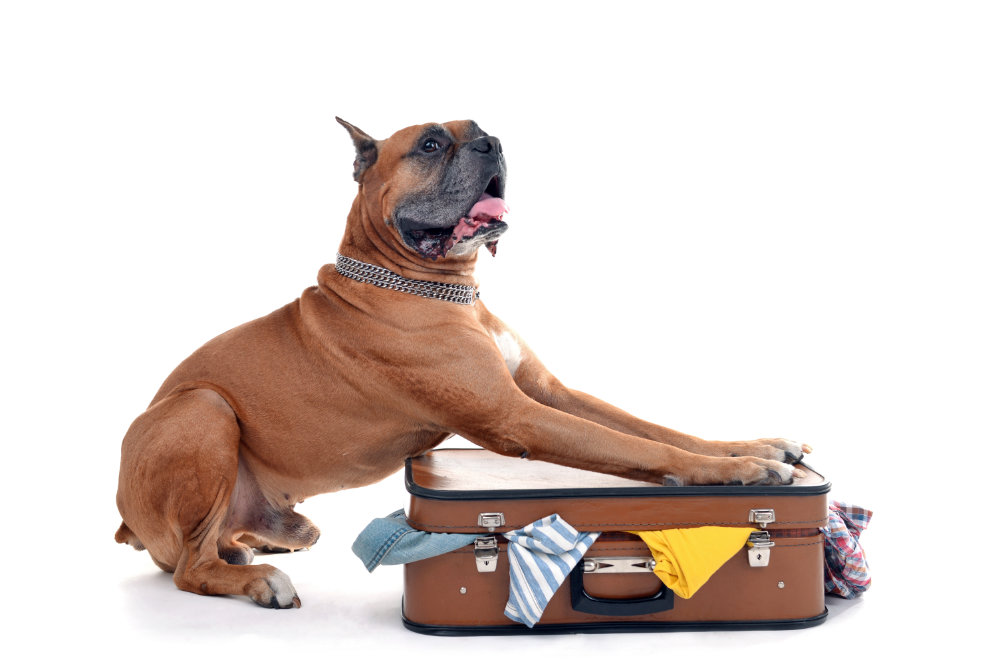
OUR VEHICLE
Our vehicle has easy access to all cages and double doors so that each pet can be taken out one by one with the assurance that they will not escape.
We have a geolocation system that allows the customer to see the location and speed of the vehicle at all times, in addition to observing the times and frequencies of stops.
Our vehicle has full type 2 license for international pet transport.
Specification includes
- Infrared cameras with monitor in the drivers cabin
- Real-time tracking using GPS geolocator
- Advanced system of temperature control
Our vehicle has an advanced temperature control system and we keep a logbook with temperature records of the trip made. We ensure that the temperatures inside the pet area are maintained in a range of 5ºC to 28ºC, with a tolerance of ± 5ºC depending on the outside temperature
OUr passengers
All our VIPets are transported in their own secure travel compartment. All compartments are equipped with non-spill water bowls and are wipe clean. They also have veterinary bedding which is waterproof and hypoallergenic. Cats are provided with a small litter tray. All VIPets are fed multiple times per day, walked every 4-6 hours and are checked continuously on the journey to ensure they are clean and happy and have plenty of water.
There are always two drivers, and they stay on the van, so our precious passengers are never left unattended.
We provide regular pup-dates with pictures sent from every walk and a video call once per day.
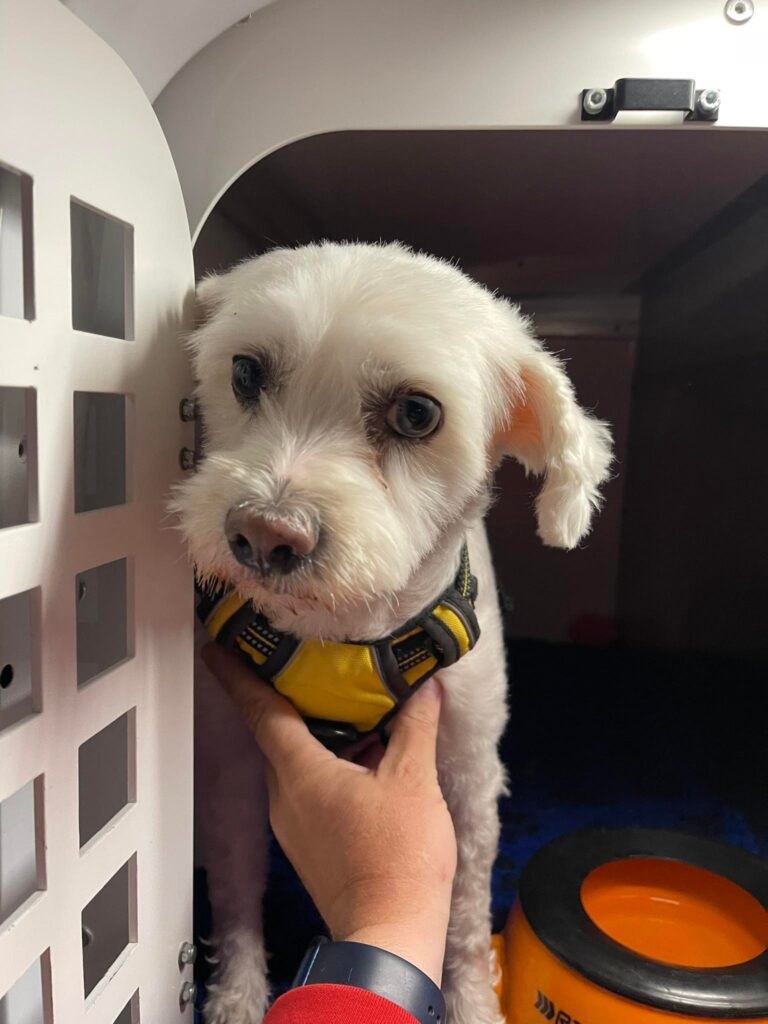
Our Happy Clients!

Cookies on GOV.UK
We use some essential cookies to make this website work.
We’d like to set additional cookies to understand how you use GOV.UK, remember your settings and improve government services.
We also use cookies set by other sites to help us deliver content from their services.
You have accepted additional cookies. You can change your cookie settings at any time.
You have rejected additional cookies. You can change your cookie settings at any time.
New rules for pet travel from 1 January 2021
Pet owners will need to follow new requirements before taking their pet to the European Union or Northern Ireland at the end of the transition period.

Pet owners are being encouraged to check the latest government advice about travelling from Great Britain to Northern Ireland or the European Union with their pets at the end of the transition period.
The government has worked alongside the European Commission to ensure pet travel can continue between Great Britain and the EU and Northern Ireland at the end of the transition period.
From 1 January 2021 onwards, the UK will have Part 2 listed status under the EU Pet Travel Scheme, meaning that people travelling from GB with their pets and assistance dogs will need to follow new requirements in order to travel to the EU and Northern Ireland.
Before taking their dog, cat or ferret to the EU for the first time after 1 January 2021, pet owners must complete the following steps. The only new requirement for travel to the EU is the use of a certificate, rather than a pet passport:
- Ensure their dog, cat or ferret is microchipped.
- Ensure that their dog, cat or ferret is vaccinated against rabies – pets must be at least 12 weeks old before they can be vaccinated.
- Wait 21 days after the primary vaccination before travel
- Dogs must be treated against tapeworm 24-120 hours before landing, if they are travelling to a tapeworm free country.
- Visit their vet to get an animal health certificate (AHC) for their pet, no more than 10 days before travel to the EU.
Pets and assistance dogs will also need to enter the EU through a travellers’ point of entry (TPE) , which includes all the major French ports such as Calais, Caen and Dunkirk.
All of these requirements will also apply for movements of pets and assistance dogs from Great Britain to Northern Ireland. However recognising that these changes will take time to adjust to, the UK Government is working with the Department of Agriculture, Environment and Rural Affairs (DAERA) in Northern Ireland on an enforcement approach that takes this challenge into account. This approach will be implemented in a way which supports pet owners and assistance dog users while the Government pursues a permanent solution.
There will be no change to the current health preparations or documents for pets entering Great Britain from the EU or Northern Ireland from 1 January 2021.
Christine Middlemiss, UK Chief Veterinary Officer, said:
We have been granted ‘Part 2’ listed third country status by the EU which will ensure that travelling with your pet continues from 1 January onwards. Your vet will be able to advise what you need to do in order to obtain the correct documentation to travel and you can find the latest pet travel advice on gov.uk or by searching ‘pet travel’.
Updated guidance on pet travel has been available since November 2018, ensuring that owners will be ready for any future scenario, so many pet owners will already be familiar with that they need to do.
The UK government is continuing to press the European Commission to secure Part 1 listed status. The UK has one of the most rigorous pet checking regimes in Europe and currently meets all the requirements for Part 1 listed status under the EU Pet Travel Scheme.
The latest advice for pet owners seeking to travel to the EU after 1 January 2021 can be found here .
Further information
- Passengers should always check the rules of the country they are travelling to for any additional restrictions or requirements before they travel.
- For information on commercial imports and exports of dogs, cats and ferrets to the EU – please refer to the Border Operating Model
- There will be no changes or new requirements on movements from Northern Ireland to Great Britain.
- There will be no changes to the current health preparations or documents for pets entering Great Britain from the EU in the immediate term, as the disease risks remains unchanged.
- There are no restrictions on bringing pet rodents, rabbits, birds, invertebrates, amphibians and reptiles to the UK from EU countries.
- Contact the Centre for International Trade (Carlisle) for more information on the rules for travelling with other species of pet.
Share this page
The following links open in a new tab
- Share on Facebook (opens in new tab)
- Share on Twitter (opens in new tab)
Related content
Is this page useful.
- Yes this page is useful
- No this page is not useful
Help us improve GOV.UK
Don’t include personal or financial information like your National Insurance number or credit card details.
To help us improve GOV.UK, we’d like to know more about your visit today. We’ll send you a link to a feedback form. It will take only 2 minutes to fill in. Don’t worry we won’t send you spam or share your email address with anyone.

How to Travel with a Dog Between the UK and Europe
One of the best things about travelling in Europe with a dog is that it’s usually so easy! Generally you don’t require any paperwork for travelling from country to country and most transport options allow dogs. However, this isn’t the case if you’re departing the UK to travel to Europe with a dog, or on the other hand you’re trying to travel to the UK with a dog .
For starters, dogs aren’t allowed on the otherwise-so-convenient Eurostar from London , almost the only train service in Europe that doesn’t allow any size pet dogs. Additionally, pet dogs are also not allowed to fly into the UK in plane cabins, only as cargo, and there are limited flight options when leaving the UK. So, how do you take your dog from the UK to continental Europe , or vice versa?

Note: This post contains affiliate links, which means I may receive commission if you make a purchase using the links.
Looking for information on travelling to or from a specific country? Check out my guides on:
- How to take your dog to France
- How to take your dog from the UK to Spain
- How to take your dog to Northern Ireland
- How to take your dog to the Republic of Ireland
- How to take your dog from the UK to the USA
- How to travel to the UK from outside of Europe
Can You Take a Dog on the Eurostar?
It would be wonderful if you could quickly and easily head from England to France, Belgium or the Netherlands with your pet dog on the Eurostar! Unfortunately though, no pet dogs are allowed on the Eurostar . The only dogs that are allowed on the Eurostar are assistance dogs, and even then they need to be booked in advance.

It would be terrific if this changed to allow pets on the Eurostar, but there are currently no plans for this to change. It’s especially perplexing given that dogs are allowed on trains in both the UK (for free!) and in France.
Taking a Dog on the Ferry as a Foot Passenger
Generally, most of the ferries that travel between the UK and continental Europe only allow passengers with a vehicle to bring along dogs. This is because most of the time pets must stay in the vehicle, or they do not have facilities for the boarding of foot passengers with pets.
There are only a handful of exceptions, with the following four ferries allowing foot passengers to take a dog. Best of all, most of these ferries now have pet-friendly cabins available.

Ferry from Newhaven to Dieppe (DFDS Seaways)
This is the only ferry between England and France that allows foot passengers to bring their dog. A charge applies, which was recently £22. The journey is about 4 hours (longer than the shorter Dover to Dunkirk or Calais routes) and dogs are kept in kennels on the car deck for the entire journey. Pets must be carried on board in a pet carrier.
Ferry from Harwich to Hook of Holland (Stena Line w/ Pet-Friendly Cabins)
This longer crossing takes up to 9 1/2 hours (with shorter crossings during the day), but is quite popular with dog owners as it is more pet-friendly.
Recently, pet-friendly cabins were introduced on the ferries. Choose between two-berth inside or outside cabins, or larger five-berth cabins with a window. Up to three small pets under 15kg are permitted in each cabin, or two medium-sized dogs under 30kg, or one large dog over 30kg.
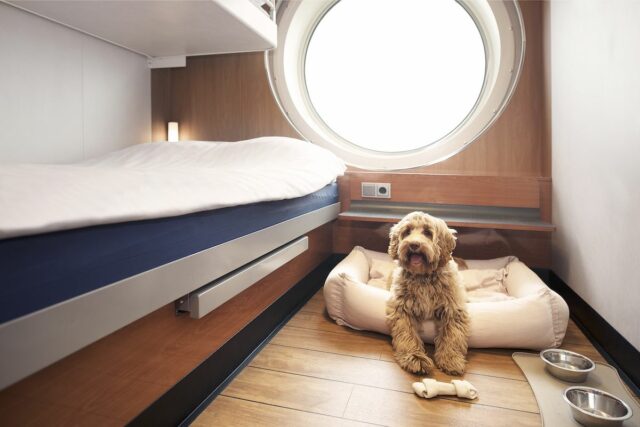
Additionally, there is also the option of booking a kennel, with two kennel rooms that remain accessible during the voyage, plus a TV channel showing CCTV footage from the kennels. Outside on the deck is a pet exercise area, although be warned it is just bare deck.
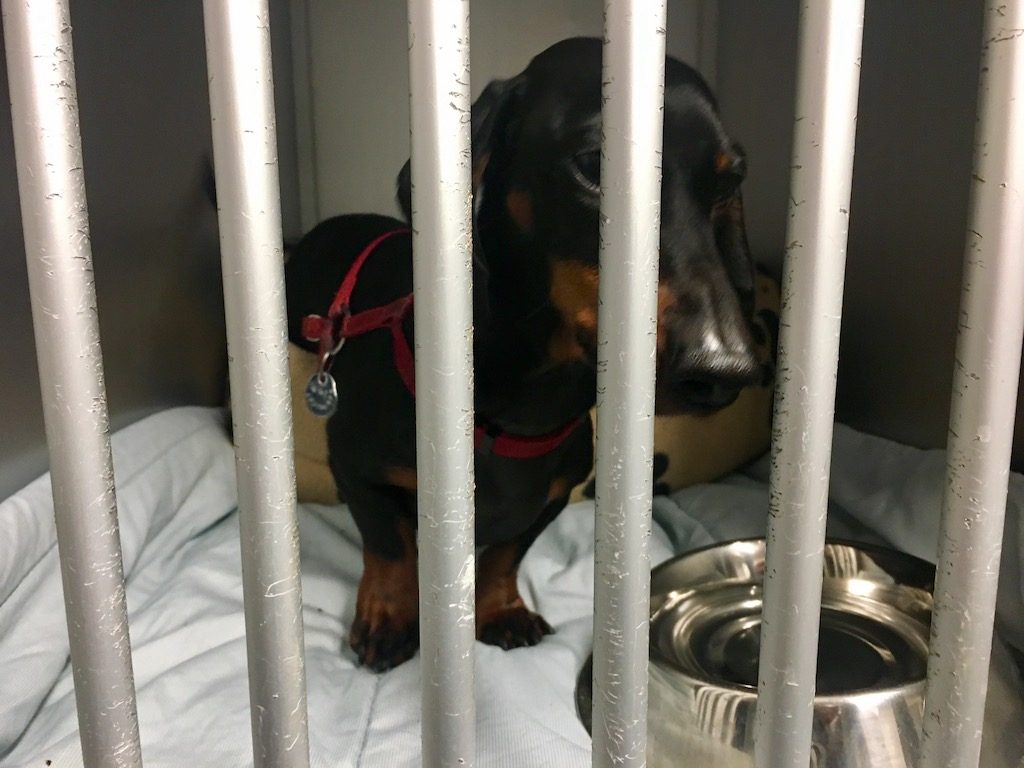
There is no additional fee for pets staying in a pet-friendly cabin, although the cabins themselves are more expensive. The charge for pets to stay in a kennel is £21. (Car passengers also have the option of leaving dogs in their car, with a fee of £18 applying.)
Read my review of travelling between London and Amsterdam with my dog on this ferry, on the overnight sailing. It is possible to book online ; simply select a pet-friendly cabin if desired at the cabin step, then add your pet to your booking at the next step.
Recently, a limit of three pets per foot passenger has been imposed (or five pets per vehicle).
Ferry from Newcastle to Amsterdam (DFDS Seaways w/ Pet-Friendly Cabins)
This ferry service to Amsterdam also offers dog-friendly cabins as well as kennels, with both available to foot passengers as well as car passengers. The pet-friendly cabins are four-berth sea-view cabins that can accomodate up to two medium-sized dogs.
This crossing is a more convenient option for dog owners travelling to or from northern England or Scotland. Note though that the journey time is much longer – nearly 16 hours.
There is a charge of £30 per pet in either a cabin or kennel. Foot passengers travelling with a pet need to book by calling the contact centre .
Read this review by someone else taking the ferry or find out more about the DFDS pet-friendly cabins and travelling with a pet on DFDS ferries in general .
Ferry from Hull to Rotterdam (P&O w/ Pet-Friendly Cabins)
This ferry service also connects northern England with the Netherlands, but this time the ports of Hull and Rotterdam. The journey time is about 11 hours, with the service generally operating overnight.
Recently, three pet-friendly cabins have been added on each ferry. Each cabin is a two-berth ensuite cabin with a window, although with a restricted view. Each cabin can accommodate two small or one medium/large dog. Naturally, they should be booked well in advance, plus they cost more than standard cabins.
The pet-friendly cabins are located on deck 7 close to the kennels and exercise area. It’s also possible to book one of the air-conditioned kennels, with three sizes available. While the kennels cannot be visited during the crossing, they are regularly checked by staff members overnight.
There is a set fee of £22 per pet, charged regardless of whether your pet travels in a kennel or cabin. It’s easy to add a pet to an online booking, for those travelling with or without a car, plus select a pet-friendly cabin if available.
Another way that P&O has made their crossings more pet-friendly is by setting up a pet exercise area at both the Hull and Rotterdam Ferry Terminals, for some last minute exercise before boarding the ferry.
Find out more about taking your pets on P&O .
Taking a Ferry with a Car and a Dog
It’s a lot easier to travel in between England and continental Europe with a pet if you also have a car! The majority of ferries travelling between England and continental Europe allow passengers travelling with a car to also transport pets. Click here for the full list of approved ferries.
Check out my full guide to pet-friendly cabins on ferries to Europe
Another recently development in 2023 has been the introduction of pet lounges on the P&O ferries between Dover and Calais. Instead of leaving your dog in your car, you can travel together in the lounge, with access to an outside exercise deck. A fee applies for access, with only dogs allowed. Additionally, only those with a vehicle can travel with pets, not foot passengers.
If your dog is staying in your car, it’s best to choose one of the quicker ferry options, such as between Dover and Calais, particularly if travelling in the warmer months.

Most ferries charge a fee per pet, usually around £22 except on the longer voyages to and from Spain, although the exact fee varies between the different companies. Check out the websites of the individual ferry companies for more information.
I’ve also put together detailed guides on taking the ferry to France with a dog and taking the ferry to Spain with a dog , with a list of all options and their pet facilities.
Taking the Eurotunnel with a Dog
The second option available if you have a car, and probably the more convenient one, is to take the Eurotunnel car shuttle train. Your dog stays in your car along with you, and the actual crossing only takes 35 minutes. There is an additional charge of £22 per pet, in each direction.
At both Calais (France) and Folkestone (UK) you will need to report to the Pet Reception Centre, prior to checking in. Make sure you allow additional time for this step. Here your dog’s paperwork will be checked.
See further details on the Eurotunnel website about transporting dogs via the Eurotunnel.
Note that the Eurotunnel doesn’t take foot passengers, with or without a dog.
Flying to the UK with a Dog
If you’re wanting to fly to the UK with a dog, the only option available is for your pet to fly as cargo. No dogs are allowed to travel to the UK in the plane cabin, except for assistance dogs, or as checked luggage.
Click here for the list of approved airlines , including the approved destination airports, or alternatively check the pet policy of the airline you intend to use, as many airlines that fly pets elsewhere in Europe don’t offer the option of flying pets as cargo to the UK.
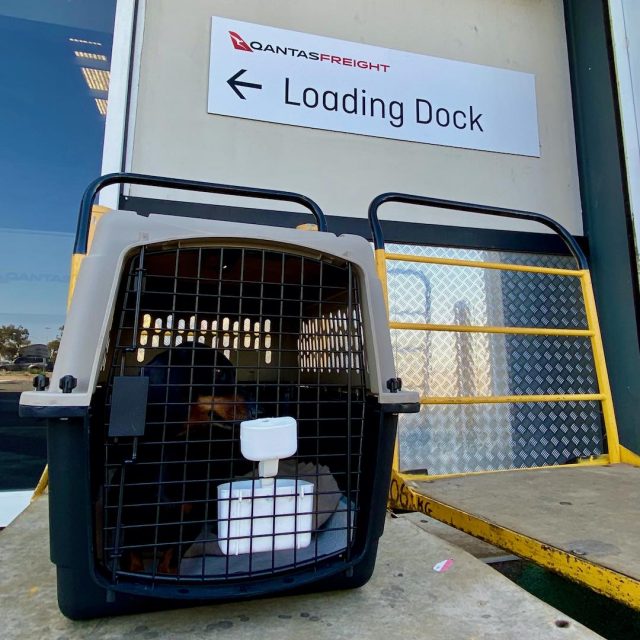
Depending on the airline, you may be required to use an animal transport company, meaning it can be quite expensive. Additionally, there is a large fee payable when you collect your pet from the quarantine office. On top of that, the process is reportedly quite time consuming and you need to make an advance booking – Heathrow in particular is often booked out in advance.
Is it any wonder that most people avoid flying to the UK with their pet?
Flying out of the UK with a Dog
While pets flying into the UK must travel as cargo, the rules are more relaxed for flying with pets out of the UK. Dogs are allowed to travel in the cabin or as checked luggage. However, there are only a limited number of airlines that offer this.
Check out my guide to the latest airlines that fly dogs out of the UK , whether in the cabin or as excess baggage. Two of the European airlines that clearly specify they allow this are Air Malta and TAP Air Portugal. Additionally, I’ve heard reports from fellow travellers of Air France, KLM and Lufthansa allowing this.
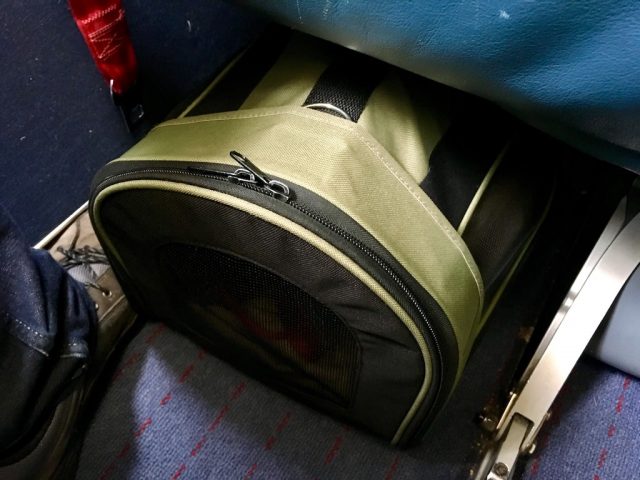
I recommend phoning up the airline you are considering using to find out if this is an option, plus noting down the details of who you spoke to and when if you do get the okay. Note that none of the UK airlines allow pets to fly in the cabin at all.
Taxi Services Across the English Channel
The other alternative if you’re travelling between the UK and continental Europe without a car, and are struggling with the limited transport options available, is to utilise a taxi service. There are multiple providers that will basically take you on a taxi ride, along with your dog in the vehicle, but a slightly different taxi ride as you’ll be taking the Eurotunnel with the taxi.
Generally you just take the taxi between Folkestone Central station and either Calais Ville or Calais Fréthun station, utilising trains on either end. Expect to be charged at least £100-200 in addition to the Eurotunnel cost.
There may also be the option to travel a further distance on each end, such as all the way from London, for a higher cost. A typical fee from Paris to central London is £700, including the Eurotunnel cost.
For further details on taking a dog taxi from the UK to France, contact:
- Folkestone Taxis (also known as Pet Travel Abroad)
Prefer to not pay the expense of a private taxi? Another more recent option is Le Pet Express , which has regular scheduled mini-bus crossings, between Ashford and Calais Frethun rail stations. The shared mini buses can transport up to five pets and six people, with you travelling beside your pet. At the moment there are crossings on Saturdays and Sundays.
Additionally, there are some companies that are specifically set up to transport dogs longer distances between European countries and the UK, not just across the channel. These companies can collect your pet from an airport or city in Europe, then transport your pet to your door in the UK.
One such company is Happy Saluki Pet Transport , which is DEFRA certified. Another alternative is Pet Courier , a Spanish company that specifically transports pets between the UK and Spain, and vice versa.
What Paperwork is Required for my Dog?
To travel with a pet from the UK to the EU , your dog or cat needs to be microchipped, vaccinated for rabies at least 21 days before your day of travel and either have an EU animal health certificate or a pet passport issued in the EU or Northern Ireland.
Additionally, if you are travelling to the Finland, Ireland or Malta (plus Norway), your dog now needs to receive a worming treatment from your vet. For full details, see the UK government website .
Note that following Brexit, Great Britain issued pet passports are no longer valid, and you will need to visit a vet before each trip for an animal health certificate. However, if you have an EU or Northern Ireland-issued pet passport ( Northern Ireland is technically part of the EU for pet travel purposes), these are still valid.
If you require an animal health certificate, I’ve heard recommendations for Abbeywell Vets located in Folkestone, close to the Eurotunnel terminal and the Dover ferry port. You can request an EU animal health certificate online for collection when you arrive in Folkestone for a reasonable price.
Prior to Brexit, when heading from the UK across to continental Europe, generally no paperwork for pets was checked. However, this is no longer the case, so allow additional time.
For more tips on everything to organise and other parasite treatments to consider when travelling to Europe with your dog, check out the pet travel guide put together by The Daycare Vet .
When returning to the UK , similar requirements apply. The animal health certificate used to leave Great Britain can be used to return to Great Britain, with a validity period of four months. Alternatively, a pet passport, including a pet passport issued in Great Britain prior to 2021, can be presented. Otherwise visit the vet to get a Great Britain pet health certificate.
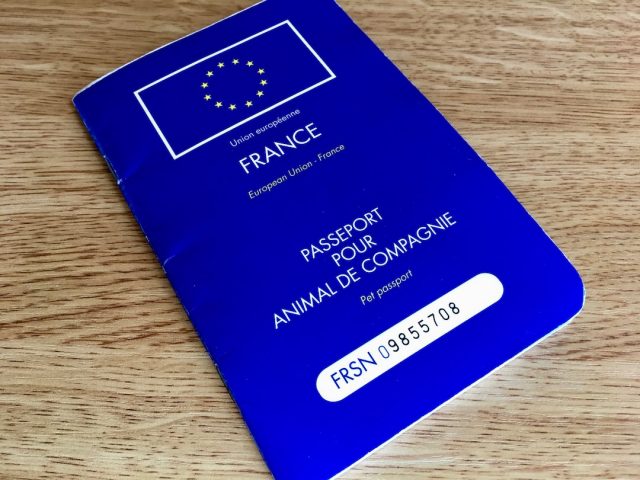
Note that all dogs (except for those entering directly from Finland, Ireland, Malta, Northern Ireland or Norway) will need to be administered a worming treatment by a vet between 24 hours and 5 days of entry into the UK, with this recorded in your dog’s health certificate or pet passport.
Be prepared for your pet’s paperwork to be carefully checked when returning to the UK . The UK is is very strict about dogs entering the country, so make sure everything is in order. The timing of the worming treatment is checked down to the hour, plus the rabies vaccine is carefully checked.
For more details on the paperwork required, see the UK government website .
About the Author

Shandos Cleaver is the founder of Travelnuity: Dog-Friendly Travel. She has travelled extensively with her Miniature Dachshund, Schnitzel, including to 33 countries across Europe, every state and territory of Australia except Tasmania, and 10 of the United States. She’s passionate about providing inspiration and information to others wanting to travel with their dogs, whether close to home or internationally.
Inspired? Pin this to your Pinterest board!
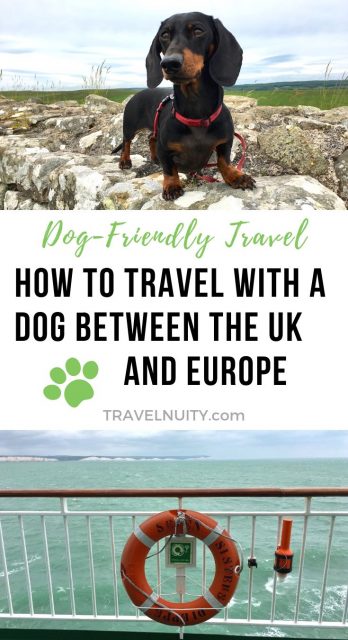
81 thoughts on “How to Travel with a Dog Between the UK and Europe”
Thank you for this! What an amazing resource. My partner and I are looking into working holiday visas and the UK was our first choice since we have a common language. But we got discouraged when we thought we wouldn’t be able to bring our dog. So thank you so much for all of this info! Super helpful!
https://teaspoonofadventure.com/
Glad it’s helped you! Hope you have an amazing time on your trip, whether that’s in the UK or somewhere else. 🙂
dont forget that worming pil alot of people get caught out by that ,,i cant remember the name for the worm
How about taxis, most of the taxi drivers in London they refuse the journey when they see the pet, how about your experience. thanks for sharing
I’ve had both experiences with catching taxis in London – being refused or accepted (although I guess it helped that my dog is small and was in a carrier bag). It’s helpful if you can advise in advance that you have a dog.
With crossing the channel in a taxi, it’s a specific service offered by these companies that you book in advance, advising that you have a dog. I’m sure they wouldn’t refuse if it’s all been properly booked!
This is a great series but I’m really surprised that you haven’t once mentioned the banned dog breeds in Europe! As owners of the soppiest, softest, daftest, most laid back (breed indicative!) Bullmastiff, we were shocked to discover that we are unable to drive through France with her. We are however looking at options to take the ferry straight to Spain instead! The Caravan and Motorhome Club has some info, but we’ve found that this is not a widely publicised subject which could catch out unsuspecting owners. https://www.caravanclub.co.uk/overseas-holidays/useful-information/travelling-with-pets/
Thanks for sharing the informative post! I’ve recently written about this on my post about France ( http://www.travelnuity.com/dog-friendly-france/ ), but will add further details to other posts as I read up further.
This is a concern of mine as well! I plan to tour Europe with my dog on an extremely extended trek, but she is a pit-hound mix. I think I am going to mostly rely on the fact she looks more like a hound dog and hope that saves us! If I could get her to howl on command, that would convince everyone. You can’t mistake the distinct hound baying xD
My final hope is that the muzzle that is required in many areas doesn’t ruin the illusion. Covering her very hound-y snout might draw more attention to her very pit-y ears. : {
As for crossing from France to England, I have half a mind to hitch hike, LOL!
Hitch hiking is an option! Not sure if Bla Bla Car operates in the UK, but I’ve heard of some people having success with it and a dog.
I’ve recently written more on the topic of dangerous dog rules here: http://www.travelnuity.com/travel-with-dangerous-dog-breed/
Fantastic resource! Struggling to get our toy poodle from Croatia/Italy back to the UK. Any advice???
It sure is tricky returning pets to the UK, unless you’re happy to have them travel as cargo (and pay the cost)! Probably my favourite recommendation (and that of many people I’ve spoken to) is flying to Amsterdam and then taking the Stenaline ferry to Harwich or the DFDS ferry to Newcastle. Alternatively, if you would prefer to travel by train, I recommend checking out Man in Seat 61 for the options.
I need to get my Brussels Griffon from Croatia to UK – have you any solutions?
I recommend flying to either Paris or Amsterdam, then taking the ferry or a pet taxi on the Eurotunnel. Alternatively, there’s companies that can provide end to end land transport from many countries to the UK
Such a great help. Thank you! We are getting the Eurotunnel to France with our dog and then driving up to Belgium. I’ve struggled to find anything about traveling between countries in Europe and can only assume that we don’t have to do anything between France and Belgium? Just the vet stop in France on the way back? If you can offer any advice I’d be ever so grateful. Thank you!
Georgia – Great to hear about your plans! For travelling with your dog between EU countries (and other countries like Switzerland), you’re required to have their pet passport and a rabies vaccine at least 21 days old, but this is rarely checked (except for UK and Malta, possibly Finland and Norway, that all requires the worming treatment). Expect to show nothing when travelling from France to Belgium, the same as regular passports are not checked. And yes, stop at the vet between returning to the UK for the worming treatment, at least 24 hours before returning to the UK.
Thanks for the clear and up-to-date information. This is an invaluable help as it can be hard to get clear information about pet-travel in one place, which can be very confusing. I really appreciate it !
Glad to help Neil!
Excellent information, thank you. I moved to Cyprus 2yrs ago with my dog in cargo and he was severely traumatised to the point that I thought he may die as he stopped eating. Then he got hit by a car and is now paralysed. I am desperately trying to get back to the UK but am struggling to find a way off the island without putting him in hold again. He weighs too much to go as hand luggage and i have to toilet him every 4hrs so cargo is not an option. Any suggestions? Thank you
Unfortunately I haven’t yet been to Cyprus, so I’m not fully across the transport situation. One option might be taking a ferry, then trains across Europe (see https://www.seat61.com/Cyprus.htm ). I know the ferries in Greece allowed dogs on the outside decks. But Greece has restrictions on larger dogs on trains, and Turkey may have the same. Not to mention this is a long journey.
I’d recommend looking into an animal transport company, who may operate vans where they transport dogs. I’ve heard of this before, but haven’t used it in Europe. Additionally, speak to your vet whether they can recommend something to help your dog, if you do end up resorting to cargo again. Sedatives aren’t usually recommended, but are an option if you work out a plan and trial it with your vet.
Can you tell me if you have to pay someone to go through customs at both the CDG airport if flying into France with your dogs, and then at either border, France or UK, when taking the on-foot ferry option or the overnight ferry option from Amsterdam?
Kelly – Sorry for taking a while to reply, I haven’t had decent internet access lately. The great news is that no customs fee is payable arriving in CDG or crossing the channel. The only customs fee in Europe I’m aware of is flying into the UK. Hopefully this doesn’t change with Brexit.
Hi! I am thinking of taking a small-sized dog, but I live in the UK. I travel to Sicily quite a lot (my home is there) and was thinking if you could suggest the best option to travel there. How expensive could that be?
It’ll be easier to travel to Sicily with your dog, as some airlines accept dogs flying out of the UK (perhaps Alitalia, I haven’t heard reports), but flying back into the UK dogs can only travel in cargo. Most people avoid this (and the high cost) by flying to a nearby city and then driving back across (on a ferry or the tunnel) or taking the ferry. I’ve covered these options in this post. I recommend contacting an airline directly for a cargo quote. The cost of driving or taking the ferry is trickier to estimate as it varies depending on your choice and has multiple components.
You are very helpful. I’ve spent about 20 minutes on your site and you’ve done a very good job responding to comments and being a presence in your community niche. Good job!
Hi, I am travelling from U.K. to Brazil with my pet in the cabin. However my flight has a connection of 1:30 hour in Amsterdam, where I will change the aircraft but won’t leave the lobby of arrivals and departures. I already have all the documents required by Brazilian authorities. Do you know if I have to apply for any additional document to present in Amsterdam or the health certificate issued by British authorities is enough?
If you’re not leaving the airport in Amsterdam, you don’t require anything. However, if you wish to leave the airport this depends on whether this is this year or next year after the end of the Brexit transition. At the moment, your dog would just need a EU pet passport, showing the valid rabies vaccine. However, this is often not checked.
Thank you so much for this post!! I have struggled so much in finding good information to take my pet from the Uk to Switzerland.
I am moving and I have also lots of luggage, do you recommend anything on this situation?
I was planning on renting a car but because I’m not 25 yet this is not an option for me unfortunately.
Once again thank you for taking the time on writing this post.
Thanks so much Mariana! There are some services that will deliver luggage for you, but I’m not sure of the costs involved. Alternatively, I’d recommend using a taxi to cross the channel (and loading it up with your luggage), plus investigating using BlaBlaCar (car pooling), specifying you have extra luggage.
Does BlaBlaCar work well? I saw this even searching for ways to cross but did not look into it heavily… I’ve been wanting to drive and hook up a dash camera to record to country side of France and England.
I haven’t used it, but have had it recommended by others online, although this was pre-Covid
You can send your luggage before you leave to where you’re going out have someone do it for you after. I’m going to see my mum and I’m going to Oxford flying into France from the USA. I spent £256 to send two bags at 72lbs and 60lbs from Oregon USA to Oxford England.
Hello, thanks for this very useful guide! I want to go from Paris to London with a cat, and I have one question: is there a way of renting a car to go from Paris to London (and drop the car in London) with my cat? I am from the USA, so I am not sure if there are any special restrictions I need to take into account, or if rental companies even let you have a cat in the car. Thanks!
Sebastian – I looked into this when I was travelling the same route, and found most car companies either didn’t permit a one-way hire or charged a fortune for it. Most car hire companies don’t have rules against pets in the car in France, although I would ideally keep your cat in a carrier (for their own safety, too) and remove any pet hair before returning it.
Did you end up paying a lot for a car rental?
Sorry, I’m not sure what car rental you’re referring to. We had multiple both in France and UK, but didn’t get a one-way rental
Hi, Shandos! I’ve been trying to look everywhere for the answer but I’m traveling from the USA to France where I’ll spend a few days. I’m traveling (likely flying) to the UK soon after and was wondering if I need two separate health certificates (one from France) even if I’d be traveling with a USA-endorsed certificate within the 10 days it’s valid.
If I need only one, do I need to have the health certificate for France or for the UK? Is either accepted by either country? Thank you so much for your help!
Unfortunately, you’ll need a 2nd health certificate – the GB pet health certificate. France only accepts the EU one, while England/Scotland/Wales only accept the GB one. It will be best if you have both completed in the USA, or else have the GB pet health certificate completed in France. For the UK, pets also need to be wormed within 5 days of arrival, but at least 24 hours in advance, which sounds like it’ll be easier done in France if you spend a few days there.
Have you gone yet? I’m doing the taking my cat to France CDG this month trying to book my tickets for the ferry or taxi across to England
Just wanted to let you know the link under Folkestone Taxi did not work. Thank you, hope all is well
Thanks, I’ll check it out.
In case you are not aware the rules post Brexit have changed at Eurotunnel. Generally for any pet there is a new requirement for travel from the UK to France to have a health declaration which is obtained at a vet and costs around £160 per pet. This is because France now does not recognise the UK Pet Passport. And at Eurotunnel there is a new Pet reception centre you have to visit to board the train with your dog.
Thanks for the information on the new pet reception centre! As I’ve mentioned elsewhere on my blog, yes a health certificate is now required to travel from the UK to France. This article is due to be updated soon.
Great website! Has anyone had experience travelling from Amsterdam to Newcastle by ferry as a foot passenger? The website gives conflicting info 🙁 Are you allowed to take a small dog with you on this route?
Many thanks!!
You should be able to take a small dog in the pet-friendly cabins, I know people who have done this. However, this may be impacted by Covid, so I recommend calling to confirm.
Air France, KLM and Delta allow flying out of the UK with a pet in cabin also.
Thanks for sharing!
Hi, I was looking at taking my dog on the plane from Uk to Kosovo which is possible but the return cost for the dog is very high. More than I paid for my family tickets. I would like to know if I can travel with my car from Uk to Kosovo with the dog. I have done this journey many times before without the dog but not sure what is required re: travel with dog in the car. Thanks
It’s quite easy to drive through Europe with a dog in your car. To travel from the UK to France, you’ll need to visit your vet to get an EU pet health certificate, within 10 days of your arrival in France. The price for this varies quite a bit. This can also be used to re-enter the UK, if your trip is under 4 months, plus you need to get a worming treatment recorded between 24 hours and 5 days before returning to the UK.
Once you are in France, keep the EU pet health certificate. You need this to cross borders within the EU (and Switzerland), but it is unlikely anyone will ask to view it. However, I’m not sure what is required to enter the non-EU countries, like Bosnia and Kosovo. I recommend checking the government websites in advance.
Actually, I just realised one other thing. If you travel to the EU after travelling to a few countries in Europe outside of the EU, including Montenegro, Serbia and Kosovo, you pet will need a rabies titre test also. The list of exempt countries and territories is here: https://ec.europa.eu/food/animals/movement-pets/eu-legislation/listing-territories-and-third-countries_en . More information is here: https://ec.europa.eu/food/animals/movement-pets/eu-legislation/non-commercial-movement-non-eu-countries_en .
If you have this done before leaving the EU, there is no waiting period (normally there is a 3 month waiting period), but I am not sure what happens if you have this done in the UK, see such the UK is no longer part of the EU. I recommend speaking to your vet for advice.
Hi, my mum is moving to the UK with her dog from Malta. Planning to fly to France/Belgium then drive or ferry to UK. If paperwork and worming treatment is done in Malta (up to 5 days prior) is that enough or will she need to see a vet in France?
That should be fine, assuming she also has a valid EU pet passport to travel to France/Belgium.
Hi Shandos! Thanks for the blog post, very helpful. I just wanted to share for people that will need to travel between EU and UK regularly: every time you travel from the UK you will need a health certificate, as those expire, but if you actually register your pet with a Vet in an EU country (I did it in Barcelona, Spain) you can then get a Pet Passport recognised by the EU. This will allow you to travel back without needing to spend every time in a health certificate, which can cost £150+. The requirements to get the passport in Spain were pretty simple: they didn’t asked for min period of time (but this could be different depending on the practice apparently), show the vaccine records and the cost for my dog was around €50. I don’t know how this can be done in other countries or even regions of Spain, but worth checking. Hope it helps someone else!
Thanks for sharing Julio, including how easy it was in Spain. Unfortunately France has been making it more difficult to get an Eu pet passport there unless you live in France, but with the high cost of pet certificates it’s worth trying.
Hi Shandos, Thank you very much for your great website! 🙏 Can you please help me, as far as I’ve read (e.g. https://heathfieldvets.co.uk/travelling-to-the-eu-post-brexit/ ), UK vets can no longer stamp raibies vaccines into EU pet passports. Which means, that if you are going to get an EU pet passport, you will have to take your dog back to EU *every year* for the vaccination. Did I get that right? Because if yes, it doesn’t seem cost effective to have a EU pet passport 🤔
Yes, that’s now the case, since the UK left the EU. Some rabies vaccinations are valid for 3 years, but it only makes sense to go down this route if you are planning on regularly visiting the EU with your dog, such as spending a few months each year there.
Thank you again! 😊
United allowed flying out of Edinburgh in cabin. Also note Stena Line Hook to Harwich now has pet cabins you can book for the night trip, and their day crossing at 14:15-19:45 looks to be shorter (our doggie is very old and I don’t think we could leave her in one overnight). We have done the DFDS to Newcastle several times. They looked at her EU passport when departing AMS but not when arriving in Newcastle both times. After finding it just as difficult to get to their bus in Amsterdam last time however we took a train to the closest point and then called and Uber. We also took an Uber on the Newcastle end the last time.
Thanks for the updates George, I’ll look into this!
Hi Shandos! Do you have any experience/suggestions for travelling to the UK from Portugal with a 20kg friend? It looked for a moment like British Airways might be a possiblility through the cargo handlers IAG but it seems they don’t list Portugal as an option…
Portugal to UK is a tricky one at the moment! Lufthansa might be able to do it on a flight via Frankfurt, but I heard a few weeks back that they temporarily were stopping transit flights for pets due to low staffing levels from Covid.
Alternatively, there’s multiple pet transport companies that will transport pets in vans from throughout Europe across to the UK. Perhaps ask in a Portuguese expat group on Facebook for recommendations, or else a Google search turns up multiple options.
Hi, thank you for sharing all this information. I actually took your advice at Christmas and went from London to Malaga with my cat: Newhaven -> Dieppe -> by ferry then caught the trains (nightmare so long) then flew Paris -> Malaga.
However, we are going again in a few weeks and we were accepted in March to fly in the cabin with Iberia Express from Heathrow to Madrid then doing the fast train to Malaga. However, I just noticed that you have said Iberia no longer accept animals in the cabin? I have phoned them up a few times and they have confirmed that my cat is on the ticket. I am a little nervous now that we may be refused at the airport?
The latest I had heard is that they weren’t accepting pets, but maybe they have changed this again? If you have the ticket and you have confirmed this with them, all should be fine.
Thank you for the information, apologies if I have missed this but what is the protocol for arriving to CDG with dog in cabin? Do I need approval from the airport before I fly, if so who do I contact?
There’s no airport approval required at CDG, just a booking with an airline.
Hi ans thanks so much. for all this info. I am dual nationality, British/Irish and my dog is a rescue from Romania and has a European Passport. My plan is to take Le Pet Shuttle, (Eurotunnel) to Calais and then a train to CDG and stay in a Pet Friendly Hotel at airport. Then next day fly her in cabin with me from Paris to Faro, Portugal. I’m gonna have a stroller for her and an airline approved cabin carrier. My question is, what pitfalls should I look out for? Im a bit nervous about the paperwork.
I was gonna try Transavia Airlines.
The main requirement is that your dog still has a valid rabies vaccine in the passport. (Future vaccines will need to be done in the EU to be entered in the passport.) The paperwork will be checked before leaving the Uk, then perhaps at flight check in, but it’s fairly straight forward. Enjoy your trip!
Great & informative blog! The comments have helped me work out that Eurotunnel is best option in returning to the UK.
I would just like to double check I’m up to date with info tho.
I would like to fly from london to Faro, Portugal with my 5 months old chihuahua for a couple weeks holiday. (I used to live there before getting my puppy & still have friends over there, I am a British (born here) citizen.) I have found that I can fly out of london fine but it’s returning I’m unsure on. Preferably flying with TAP.
My question is: Will I be able to fly back with my pup if I have flown out with him or shall I try the Portugal to Calais flight then get the Eurotunnel over to the uk?
I won’t have my car tho for the Eurotunnel part, what would be the best way to get on there OR if you know a better alternative in returning to the uk from Faro, Portugal I’m happy to hear all ideas.
(Apologies for the story ha, I just want to make sure all details are in)
Yes, it’s possible to fly out of the UK with a dog in the cabin, with a few airlines, but it’s not possible to fly back in, even if you flew out, except if the pet flies in cargo. As you won’t have a car, there’s a few taxi companies I have listed that will transport you and your dog.
Lufthansa no longer allow pets in cargo to the uk. They say you need to book space on a cargo plane in order to transport your pet to the uk. British airways and Austrian airlines have said the same thing. It’s become even harder now to bring my cat to the uk.
Thanks for the heads up!
Hi! Super useful information as it’s so tricky to travel to/from the UK! I just wanted to add that dogs can travel in the cabin UK to Spain with Iberia Express (not normal Iberia). As far as I know, you have to phone several times until you get someone who knows their own rules… but it’s possible!
I thought Iberia Express had recently stopped allowing pets in the cabin leaving the UK, but maybe it is still sometimes possible? Thanks for the info!
Thanks so much for this article! The information was very helpful but I have a couple more questions that are specific to buying a puppy from a certified breeder in the UK and bringing them back home into EU.
We have put down a deposit for a puppy from a UK breeder but we live in Slovakia. We have a car so there is an option of basically taking a road trip from Bratislava to the UK (15+ hours) and back for the pup but in the end we want to choose a way to bring them home that’s least stressful for them. Do you have any suggestions on what the process is like with a 8 week old puppy and what the best options are for transport?
Thanks a lot, Anna
Anna – I’m not fully across the rules for transporting puppies. Make sure you double check the rules for puppies for EU pet health certificates – there is a slightly different process as they are too young for a rabies vaccine. Additionally, many airlines have minimum age restrictions. An alternative option is to find a land transport option. I’ve heard many recommendations for Happy Saluki ( https://www.happy-saluki.com ). I recommend reaching out to them.
Hi. I want to travel with 4kg dog to Malaga and return. I can’t be separated from a “Velcro” dog as this would cause a great deal of trauma and suffering,
I have a doctor’s letter stating that she is a therapy dog – but don’t know if this carries any weight with the authorities.
Can you suggest the simplest way to travel – whilst noting that Uk authorities have stringent rules. Also, am partly disabled myself and would need some buggy or wheelchair assistance at both Uk and Malaga airports, A two week (or less) stay in July or September. Many thanks for your help. Fully realise this is a difficult request.
The only option to do this by air with your dog in the cabin is if your dog qualifies as a service dog. Here’s the details provided by British Airways, including their contact phone number: https://www.britishairways.com/en-gb/information/disability-assistance/travelling-with-your-assistance-dog I’m not sure if your dog qualifies.
The next simplest way to return to the UK would be to fly from Malaga to Paris, then take one of the pet taxis from Paris to London.
Thank you very much for this very helpful information source! I could not find any other more informative and clear source than this!
I will be travelling with my dog (Pincher) from Italy to UK by train and then via Eurotunnel by Le Pet Express minibus as I do not have a car.
Do you know whether my dog must stay in a pet carrier whilst on train in France or he can sit on my lap or on the floor next to me. If a pet carrier is needed, are there particular size requirements?
Do I need to book a ticket for my dog as well for a train from Paris to Calais Frethun?
Calais Frethun train station for trains arriving from Paris and Eurotunnel shuttle terminal are located in one and the same place?
Thank you in advance for your advise!
The rules for whether a pet should be in the carrier on the train and the relevant ticket depends on the size. I summarise the rules for the SNCF trains in my France guide: https://www.travelnuity.com/dog-friendly-france/ . Advance booking for pet tickets is not always possible – it’s fine to buy at the station. I haven’t been to Calais myself, but I’ve heard from other travellers that Calais Frethun is the station you want to alight at. Double check with Let Pet Express for their pick-up point. All the best with your trip!
I have just done the crossing above and here are my two cents: I have had the pet passport done in Germany already so I did not have to get the health certificate. But if you do need it, schedule enough time for this as some vets need to pre gather information and put together everything which can take a while. Secondly the cages are now fixed on the ferry, there were four cages in total. Besides my JRT there was another person with a dog on the ferry. They did not make us put him into the carrier at all we and a crew member just walked our dogs on leashes to the cages. The cages are large but quite disgusting I have to say. They smell like dog urine and the pads underneath are soaked with dog urine and water. I did not like leaving my dog there but had no choice. I would suggest to bring some pee pads and portable water bowls and cover the floor so your dog does not have to sit on top of the soaked pads. I visited him once as he got motion sick during the trip (sees are rough in the winter time so if your dog is motion sick take that into account) he was fine though and in general the dogs are located in a small enclave near the cars so it’s fairly sheltered. Once it was time to disembark they told us to deboard first before all foot passengers. We went down to get our dogs and went to the lowest levels where some crew were already waiting to leave the ship. A bus was waiting to drive us to the terminal where you go through passport control (just your passport). There are no taxis or busses to Dieppe train station so you might need to walk (25min). I took trains to Paris with my dog which were quite smooth. I think the journey is ok so you can do it but personally I will get a car and travel through thr eurotunnel next time.
Thanks for sharing your experience Lisa!
Leave a Comment Cancel reply
Save my name, email, and website in this browser for the next time I comment.
Fri 19 Apr 2024
2024 newspaper of the year
@ Contact us
Your newsletters
I took my terrier on holiday to Barcelona – it’s surprisingly dog-friendly
There are more dogs than children under 15 in spain, with the catalonian city offering pet-friendly cultural spaces, parks and shops .

Gaudí is cool, sure. But inside Casa Batlló – one of the architect’s masterful creations on a major thoroughfare in Barcelona – it was my dog who was turning heads, rather than the surrealist, subtly ocean-themed interiors.
Almost every single tourist who bumbled through the crowded, curvy hallways of the house that morning did a double take when they saw him, grinning as they looked on. And he was, as always, oblivious – instead, his eyes fixated on me, expectantly, waiting for the next pungent dried salmon morsel to be dispensed.

I have to say, I had my reservations about Spain : after following dog rescue centre Galgos del Sol for many years on Instagram, I had jaded ideas of how dogs are treated in the country. Its account, which has amassed almost 90,000 followers thanks to the irreverent (though often also heartbreaking) posts, documents the trauma suffered by thousands of discarded and abused dogs in southern Spain, and their eventual rescue.
If Spanish hunters would harm and dispose of their working dogs so brutally – dogs that have often served them and raised them income for many years – how would the rest of the population see canine companions? After years of writing books and guides to dog-friendly adventures in Britain, I was a little anxious about bringing my fussy Manchester Terrier to the Iberian Peninsula.
As it turned out, I needn’t have worried. With twice as many dogs as there are children under 15 years old , according to the country’s National Institute of Statistics (INE), Spain is nearly as dog mad as my home turf.

In Barcelona, figures from 2022 suggested that over 180,000 dogs were living in the city.
Sophie Bonallack has lived in and around Barcelona since 2007 and says the city, and the wider country, has become much more dog-friendly since she moved here. “I think the huge expat community here has had a positive influence,” she says.
“More Spanish are adopting mutts and you can see it on the street. They’re less thinking that dogs are guard dogs and more that they’re a family member.”
Her four dogs get walked amid the olive groves near her home in Sitges, a short train ride from Barcelona, or on the enclosed dog beach in nearby Vilanova where there’s even a dog wash and drying room for those who come away with sand in their fur.
Mel Dymond, who is based in Raval in the south of the city, loves living here with her rescue hound, Mago.

“There are lots of dogs and dog lovers here. You can go to bars and restaurants with dogs, you can even go into shops with dogs,” she told me.
We tested this theory in Spain’s nationwide department store, El Corte Inglés, where no one batted an eyelid as we trotted through the make-up department.
It’s not all roses, mind. Not everyone loves dogs and so the city’s council has made attempts to strike a balance.
In 2024, there are new rules afoot : dogs can now only go unleashed in certain areas at certain times of day, and the local police aren’t shy about handing out fines to those who don’t abide.
But with hundreds of spaces for dogs to explore and sniff and – at the right times – run around off-lead, it’s a sweet life in Barcelona if you’re a dog.
Staying at Nobu , one of the city’s most dog-friendly establishments – where they can even join you for meals and cocktails by the pool on the rooftop and they get their own beds and bowls in the room – I was handed a dog’s guide to the city on arrival.

At their recommendation, I sought out dog-friendly gelato at Badiani Gelato Rosselló.
After our visit to Casa Batlló, which involved a strategic Aperol spritz in the sun on their dog-friendly rooftop, the guide sent us through the lively Gracia neighbourhood and uphill to another modernist icon: Parc Güell .
This world-famous park is another eccentric Gaudí creation with expansive views across the city, and it has its own off-lead area from its highest point.
Our thighs not yet sufficiently sore, we also scaled Montjuïc for a view over the port and stopped for more Aperol at Salts. This perfect sundowner spot overlooks the Olympic diving pools built for the 1992 summer games.
With just two days and the entire city to explore, we hardly scratched the surface: we missed out on trips to the dog-friendly Llevant Beach in Sant Martí , a stroll around open-air handicraft and architecture museum Poble Espanyol , and a photo op outside the supposedly nearly finished Sagrada Familia.

We didn’t even get to sample the many day trips from the city – the best for dogs being a two-hour train ride away to Montserrat, according to Barcelona-based musician Charlie Wallbank, who also happens to be the owner of the social-media-famous podencos Nala and Monkey .
It’s no small amount of effort getting from the UK to Barcelona with a dog – there’s either a 25-hour-plus ferry journey to Santander or Bilbao with Brittany Ferries , or a two-day drive from the LeShuttle terminal in Calais – so I don’t expect we’ll return too soon.
But, in the meantime, I’ll live vicariously through Charlie’s daily Barcelona dog beach sunrise videos , the perfect advert for why everyone should visit this part of Spain with their dog at least once.
Dog Days Out: 365 Things to Do With your Dog by Lottie Gross (Conway) is out on 9 May.
Travel to the EU with a pet What you need If you are travelling to the EU (or Northern Ireland) with your pet, the pet needs to be microchipped, have a valid rabies vaccination and have a valid pet passport or animal health certificate that’s accepted in the country you’re visiting. Dogs must also have had tapeworm treatment if you are travelling directly to Finland, Ireland, Northern Ireland, Norway or Malta. You cannot use a pet passport issued in Great Britain. You can only use a pet passport if the country you’re travelling to accepts them for pets coming from Great Britain and the passport was issued by one of the country’s listed here . This does not apply for travel to Spain. Animal health certificates You must get an animal health certificate in the 10 days before you enter the EU. To secure this, the pet must: have an up-to-date rabies vaccination already only need booster doses to keep the vaccination up to date If your pet needs a rabies vaccination, you must wait 21 days after the vaccination date before you get an animal health certificate. Day 1 is the day after vaccination. Tell your vet you need an animal health certificate when you take your pet to get vaccinated. This gives your vet time to prepare it. How to get an animal health certificate You must take your pet to your vet to get an animal health certificate. The certificate needs to be signed by an ‘official veterinarian’ (OV). Check your vet can issue animal health certificates. If they cannot, ask them to help you find an OV. When you visit your vet, you’ll need to take proof of your pet’s: microchipping date vaccination history Your pet’s animal health certificate will be valid after the date of issue for: 10 days for entry into the EU or Northern Ireland 4 months for onward travel within the EU 4 months for re-entry to Great Britain Your pet will require a new animal health certificate for each new trip to the EU or Northern Ireland from Great Britain. The cost of an animal health certificate can vary, but starts at around £100. If your pet is not microchipped or does not have up-to-date vaccinations, there will be additional costs. See gov.uk for further information.
Most Read By Subscribers
- TV & Film
- Say Maaate to a Mate
- First Impressions - The Game
- Daily Ladness
- Citizen Reef
To make sure you never miss out on your favourite NEW stories , we're happy to send you some reminders
Click ' OK ' then ' Allow ' to enable notifications

Brits warned they must follow new £97 rule if going on holiday to Spain this summer
Pay attention to the new law.
Tom Earnshaw
This article contains affiliate links and LADbible Group might make a commission on anything purchased.
A new travel warning has been issued to Brits as the summer season approaches, with millions of us setting our eyes on a holiday in Spain.
And it all revolves around something called a '£97 rule'.
The introduction of new rules is not a new thing when it comes to Spain, with specific rules in place for some of the country's most popular destinations .
And if you don't obey them you, could quickly find yourself paying hefty fines for breaking local laws .
With more than 15 million UK residents leaving British shores last year for a holiday in the Spanish sun, this new law is also one that we reckon you should pay close attention to.
It's all to do with Brexit and new border rules that were brought in to play following the UK exiting the European Union (EU).
Because of changes, it means Brits are going to have to show an extra two additional documents if they want to enter Spain.

It's all to do with the EU's Schengen Area, with new rules already meaning you could get banned from Europe for three years for not following them .
There are 27 countries in the Schengen Area: Austria, Belgium, Czechia, Croatia, Denmark, Estonia, Finland, France, Germany, Greece, Hungary, Iceland, Italy, Latvia, Lithuania, Liechtenstein, Luxembourg, Malta, Norway, the Netherlands, Poland, Portugal, Slovakia, Slovenia, Spain, Sweden and Switzerland
Now, the UK Foreign Office has issued residents with a warning if they're heading to anywhere in Spain, from Mallorca to Madrid.
Britons have to now show proof that they have at least €113.40 (£97) per person per day during their holiday stay.
This means that a family of four staying in Spain for a week have to show they'll have cash of at least £2,716 to hand.

The Foreign Office has said Brits could be stopped by officials in Spain and asked to prove 'you have enough money for your stay'.
Other rules brought in to play include proof of return to show you plan on leaving the country.
You could also be asked for proof of where you are staying, such as a booking reference.
The Foreign Office says: “If you enter the Schengen area as a tourist, you may need to provide additional documents at the border.
“As well as a valid return or onward ticket, when travelling to Spain you could be asked to show you have enough money for your stay."
Topics: Travel , Holiday , Money , UK News , World News
Tom joined LADbible in 2024, specialising in SEO and trending content. He moved to the company from Reach plc where he enjoyed spells as a content editor and senior reporter for one of the country's most-read local news brands, LancsLive. When he's not in work, Tom spends his adult life as a suffering Manchester United supporter after a childhood filled with trebles and Premier League titles. You can't have it all forever, I suppose.
@ TREarnshaw
Choose your content:

The real reason why fizzy drink cans have that little hole revealed
You don't actually need the hole to open the can, so why is it there.

Reason why male genital piercing is called a Prince Albert
Why anyone would want to get their genitals pierced is beyond me.

People baffled after spotting what's 'wrong' with new build house
A viral photo of someone's home is causing chaos on socials.

Brits can now book £15 flights to Ibiza and other summer hotspots but for a limited time only
You've barely got any time to take advantage as the ryanair flash sale is well underway.
- Go-to holiday destination considering fines for Brits as Spain introduces £97 a day rule
- Brits given important reminder if planning on travelling to Spain, France, Portugal or Greece this summer
- Nine major holiday destinations that are charging Brits more to visit this summer
- Holiday expert explains how Spain's new £97 daily charge will affect your holiday

EU proposes youth mobility agreement with UK to help youngsters travel, work and live in both areas
The Associated Press
April 18, 2024, 11:23 AM
- Share This:
- share on facebook
- share on threads
- share on linkedin
- share on email
BRUSSELS (AP) — The European Commission proposed Thursday to start negotiations with the United Kingdom to allow young people to move freely, work and study in both regions after Brexit — the U.K.’s departure from the EU four years ago.
According to the EU, the withdrawal of the United Kingdom from the EU following a referendum in 2016 has damaged mobility between the two areas.
“This situation has particularly affected the opportunities for young people to experience life on the other side of the Channel and to benefit from youth, cultural, educational, research and training exchanges,” the Commission said.
When the U.K. was still a member of the economic and political bloc, its nationals had the right to live and work freely in the EU, with reciprocity for EU nationals in the U.K. Under the agreement proposed by the EU’s executive arm, EU and UK citizens between 18 and 30 years old would be eligible to stay up to four years in the destination country.
The deal would also allow equal treatment of EU and UK students in the field of university tuition fees. Most EU students must now pay international tuition fees if they want to study in the U.K. The Commission says these vary between 11,400 and 38,000 pounds ($14,200-$47,300) per year and are a strong deterrent for EU students who generally don’t have to pay as much within the bloc.
The Commission’s recommendation will be discussed by EU member countries who must give the green light before the executive arm can start negotiations with the UK.
“We have successful Youth Mobility Schemes with 13 countries, including Australia and New Zealand, and remain open to agreeing them with our international partners, including EU member states,” the British government said in a statement.
The U.K. has its own Youth Mobility Scheme, which it has offered to some EU member states. The Commission believes the British plan is less ambitious than its own proposal.
“Our agreements provide a valuable route for cultural exchanges providing partner countries are also willing to offer the same opportunities for young British people,” the British government added.
Follow AP’s coverage of Brexit at https://apnews.com/hub/brexit
Copyright © 2024 The Associated Press. All rights reserved. This material may not be published, broadcast, written or redistributed.
Related News

Barcelona to get floating desalination plant to help fight drought in northeastern Spain

PSG dreaming of club treble as another French league title beckons

Belgian and Czech leaders exhort the EU to react amid concern over Russian election interference
Recommended.

DC police seek suspects in 'disturbing' Navy Yard retail theft, assault

How have drivers adjusted to the collapse of the Key Bridge? A look at the data

2 jurors dismissed from Trump hush money trial as prosecutors seek to hold ex-president in contempt
Related categories:.
Politics latest: 'Big questions' for Sunak over claims against suspended Tory MP; Sturgeon's husband charged over alleged embezzlement
Labour's chairwoman says there are "big questions" for Rishi Sunak over allegations against Tory MP Mark Menzies, who has been suspended by the party. Meanwhile, Nicola Sturgeon's husband, Peter Murrell, is charged amid a police investigation into SNP funding and finances.
Thursday 18 April 2024 23:08, UK
Please use Chrome browser for a more accessible video player
- Nicola Sturgeon's husband charged amid police investigation into SNP funding and finances
- Davidson says she'll be 'surprised' if MP accused of misusing campaign funds 'survives the week'
- Mood in Conservative Party 'very, very bleak'
- Lancashire Police say no complaints made following allegations against Mark Menzies
- Tories hit historic low in new poll - but there's bad news for Starmer as well
- Number 10 declines to recommit to spring deadline for Rwanda flights
- Explained: Why the legislation hasn't passed yet
- Live reporting by Charlotte Chelsom-Pill and (earlier) Faith Ridler
Thank you for joining us on the Politics Hub for another busy day in Westminster.
Here's what happened:
- Nicola Sturgeon's husband Peter Murrell has been charged by police amid an investigation into the SNP's funding and finances;
- Tory MP Mark Menzies has been suspended by the parliamentary party while it investigates newspaper claims he misused campaign funds;
- Mr Menzies disputes the allegations, but the Conservative Party said it was taking them "seriously";
- Conservative peer Ruth Davidson told Sky's Electoral Dysfunction podcast she doesn't think Mr Menzies will survive the week as an MP;
- The Scottish government ditched its flagship target of reducing greenhouse gas emissions by 75% by 2030;
- Number 10 confirmed again it will not be making concessions on changes to the Rwanda bill requested by the House of Lords. The legislation will return to the Commons on Monday;
- The Conservatives hit a record low of 19% for voting intention in a new poll published by Ipsos UK;
- The EU proposed a post-Brexit youth work and study scheme with the UK.
Join us again from 6am for the very latest political news.
By Adam Parsons , Europe correspondent, and Tim Baker , political reporter
Young people could be able to move more easily between the UK and Europe and stay longer to work, study and train under proposed plans by the European Union
Under the proposal, which has been put forward by the European Commission , new rules would be drawn up to allow for greater movement between the UK and EU countries for people aged between 18 and 30.
Formal negotiations have not yet begun, and a UK source told Sky News no formal proposal had been put forward by Brussels to begin negotiating on.
The proposal will be further discussed by the European Council, which represents all the nations, before negotiations start in earnest.
The plans proposed by the EU would allow young people to stay in Europe for periods of four years, with the same rules extended to EU citizens coming to Britain.
It would also mean EU students paying the same fees as British ones. Since Brexit, UK universities have charged much higher fees to European students.
Announcing the move, the European Commission said it wanted to take an "innovative" approach to tackling the barriers experienced by young people looking to travel from the EU to the UK and vice versa for longer periods.
Read more here:
By Faye Brown , political reporter
Sir Keir Starmer said police should be involved in the case of suspended Tory MP Mark Menzies, who faces allegations he misused campaign funds.
The backbench MP for Flyde in Lancashire has lost the Conservative whip after The Times published claims he had used political donations to cover medical expenses and pay off "bad people" who had locked him in a flat and demanded thousands of pounds for his release.
Mr Menzies disputes the allegations, and the Conservative Party has said it is looking into the claims and takes them seriously.
The Labour leader told reporters during a visit to Teesside: "There are obviously a lot of unanswered questions in relation to these allegations. Not least why it seems the Conservative Party took so long to act and whether they've reported this to the police, who it seems to me should be involved in this."
He said there is a "degree of frustration" that two weeks away from the local elections "yet again we're talking about misbehaviour by Tory MPs".
Earlier, Defence Secretary Grant Shapps denied suggestions there was a problem within the Tory party, telling Sky News: "There are MPs from other parties that have experienced similar problems or misdemeanours and it is right that there are processes in place."
Senior Tory Ruth Davidson says she'll be "surprised" if MP Mark Menzies lasts the week, following allegations - which he denies - that he misused campaign funds.
On the latest episode of Sky's Electoral Dysfunction podcast, which you'll be able to listen to from 6am on Friday, Baroness Davidson says the claims against him are "utterly jaw dropping".
"It is so out with the bounds of what being a responsible, elected member is and how you treat your constituency association. It is staggering, like utterly staggering," she says.
"I would find it difficult to believe that an investigation can be held and he can be cleared in time to stand a general election.
"In fact, I would be surprised if he survives the week here and doesn't just resign."
Mr Menzies is alleged to have used thousands of pounds given by donors to fund medical expenses and to have made a late-night call to a party volunteer asking for help because he had been locked up by "bad people" demanding money for his release, according to The Times.
He has been suspended by the parliamentary party while it investigates the allegations.
The MP for Fylde in Lancashire, who was one of Rishi Sunak's trade envoys, disputes the allegations but the Conservative Party said it is taking them "seriously" and "will always investigate matters put to them".
Defence Secretary Grant Shapps told Sky News earlier: "There's a process in place. He has had the whip withdrawn.
"There's further information that the chief whip I understand became familiar with yesterday and actions being swiftly taken on the basis of that further information.
"I think it is important to stress that the MP in question here denies the allegations and so on basis of sort of fairness and proper justice, I think it’s important to mention that."
To hear more from Baroness Davidson's conversation with Sky's political editor Beth Rigby and Labour MP Jess Phillips, tune into the full episode of Electoral Dysfunction from 6am on Friday.
👉 Listen above then tap here to follow Electoral Dysfunction wherever you get your podcasts 👈
Nicola Sturgeon's husband and former SNP chief executive Peter Murrell has arrived back at home after being charged by police amid an investigation into the party's funding and finances.
He returned to the home he shares with Ms Sturgeon on the outskirts of Glasgow earlier this evening.
Police said he has been charged in connection with the embezzlement of funds from the party.
He was questioned by detectives after being taken into Police Scotland custody on Thursday at 9.13am.
He remained in police custody until he was charged just after 6.30pm.
An SNP spokesperson said: "While this development will come as a shock, the police investigation remains ongoing and it would, therefore, be inappropriate to make any comment."
Over a year ago, Rishi Sunak made five pledges for voters to judge him on.
The prime minister met his promise to halve inflation by the end of 2023.
But with the general election approaching, how is Mr Sunak doing on delivering his other promises?
You can see the progress for yourself below:
The European Commission wants to open up post-Brexit talks which could make it easier for young Britons to study, work and live in the EU.
It said it would ask EU Council member states permission to negotiate with the UK government on a youth mobility agreement.
It suggested Britain had shown interest in agreements with individual European nations, but said an EU-wide approach was preferable.
Downing Street, however, suggested bilateral schemes were in the UK's best interest.
Under the prospective deal proposed by the Commission, UK and EU citizens between the ages of 18 and 30 would be able to stay for up to four years in their destination country.
It would not amount to reinstating free movement, which the UK gave up when it left the EU.
European Commission vice president Maros Sefcovic said: "The United Kingdom's withdrawal from the European Union has hit young people in the EU and the UK who would like to study, work and live abroad particularly hard.
"Today, we take the first step towards an ambitious but realistic agreement between the EU and the UK that would fix this issue.
"Our aim is to rebuild human bridges between young Europeans on both sides of the Channel."
A No 10 spokeswoman said: "The UK does have at a bilateral level a number of such schemes in place and we do that where it's in the best interest of the UK.
"And we do it as long as it meets our requirement to balance bringing in skills to the UK and exchanging those skills, but at the same time making sure that it's in line with our objectives to also be promoting and fostering UK talents and skills.
"We have spoken about wanting to reduce legal migration and also about wanting to support UK talent and skills and that's why we have a system in place whereby we have a number of agreements with individual EU member states where that works in our interests and we have that rather than a Commission-wide agreement."
Labour, meanwhile, has said it has "no plans for a youth mobility scheme".
Conservative MP Mark Menzies has been suspended from the parliamentary party in light of allegations he abused local Tory party funds to pay off "bad people".
Mark Menzies strongly disputes the claims which also include accusations he used campaign funds to pay his personal medical bills.
On the Conservatives' investigation into the claims, Defence Secretary Grant Shapps told Sky News: "There's further information that the chief whip I understand became familiar with yesterday and actions being swiftly taken on the basis of that further information.
"I think it is important to stress that the MP in question here denies the allegations and so on basis of sort of fairness and proper justice, I think it's important to mention that."
On the Sky News Daily, Niall Paterson is joined by political correspondent Darren McCaffrey to analyse how Westminster will cope with another scandal.
Plus, the Scottish government has come under fire for rowing back on its climate commitments.
Niall speaks to science correspondent Thomas Moore about the consequences of the government missing eight out of 12 of its annual climate commitments.
👉 Listen above then tap here to follow the Sky News Daily wherever you get your podcasts 👈
By Connor Gillies , Scotland correspondent
The climate gloves are off in a tale as old as time. Holyrood vs Westminster: the Green edition.
The SNP and its former leader Nicola Sturgeon stood on the global stage and won plaudits for their bold ambitions to help the slowdown in environmental doom.
Ms Sturgeon basked in a standing ovation when she boasted that Scotland was the first country on the planet to declare a “climate emergency”. But was it all talk? Was it without real substance?
The reality is the Edinburgh government, which includes Green Party ministers, has failed to hit its own targets for years and has faced claims of over promising and under delivering.
At Holyrood on Thursday, ministers climbed down from their big plans of reducing greenhouse gas emissions by 75% by the end of the decade while lashing out at cuts from Downing Street making it more difficult ( see post at 2.52pm ).
The reality is the fallout of Rishi Sunak’s backpedalling last year on the UK’s climate targets has impacted what Scotland can deliver within its constraints. Edinburgh was, in part, pinning plans on consequential cash from London.
But, is that the full story? Some would say the separate tartan targets were far from achievable.
Humza Yousaf told Sky News he is fully committed to net zero by 2045 which is still five years ahead of Westminster. It feels a political world away to say whether that date will also fall victim to tweaks and changes.
Nevertheless, it reveals the road to net zero continues to throw up surprises along the way.
People voting in local elections in England on 2 May will need to provide photo ID.
It is the second year the requirement has been in place - but in 2023, 14,000 people couldn't cast their ballot because they didn't take ID to the polling booth.
There are 22 different types of ID you can use - and if you don't have any of them, you can register for a Voter Authority Certificate.
Here's everything you need to know to avoid being caught out:
Be the first to get Breaking News
Install the Sky News app for free


IMAGES
VIDEO
COMMENTS
Practice stamp and signature of vet who administered the rabies vaccination. It is not a requirement for your dog's annual vaccinations to be up to date in order to travel to the EU, however it is advisable to keep these up to date anyway. 2. Arrange your travel to Spain. There are many different ways to travel to Spain with a dog.
If you fly with TAP Air Portugal, the cost for a pet to fly in the cabin costs €70 per flight when booked online, or €140 if you take two flights to reach Spain. For pets flying in the hold, the online booking fee is €120 per flight for pets up to 32kg (including their crate) or €230 per flight for pets between 32kg and 45kg.
To travel from the UK to Spain your dog will require an EU animal health certificate, unless they have an EU pet passport issued either in the EU or Northern Ireland. To travel to the EU they will require a microchip and a valid rabies vaccine. On the return journey to the UK, your pet will also require a worming treatment administered by a vet ...
Choose between two options: the Eurotunnel or taking a ferry, such as between Dover and Calais. (Dogs generally need to stay in your car on the ferries, so it's best to choose the shortest route, particularly if it's summer time, although P&O have recently introduced pet lounges onboard.) Take the ferry from Dover to Calais with your dog.
Pet transport company run by vets. Over 18,000 pets transported and counting. Experts in flying dogs and cats to Spain. Get in touch +44 (0)1725 551124. Get a Quote. Get in touch ... As of January 1st 2021 there have been some changes to the requirement for European pet travel, read more about ... Petair UK, c/o Tarbay Centre, Tarbay Lane ...
To travel from the UK to Spain, your pet will need the following: a microchip. a valid rabies vaccination. an animal health certificate (AHC) if your pet is travelling within 5 days of your own journey (unless you have a pet passport issued in an EU country or Northern Ireland) an export health certificate (EHC) if your pet is travelling more ...
Discuss your travel plans with your vet and obtain a health certificate confirming your dog's fitness for travel. Part 2: Taking Flight with your Furry Companion 1. Airline Options: Several airlines allow pets on flights from the UK to Spain. Here are a few popular choices:
Brittany Ferries - You can travel from Portsmouth or Plymouth to Santander or Bilbao, the crossing takes between 20 - 28hrs. Depending on the route. Your dog can either stay with you in a Pet Cabin or will be in a kennel, the kennels cost £45 per dog You need to plan ahead for the ferries as the Pet Cabins and kennels go very quickly. You ...
A Spain Pet Passport is a compilation of documents that your dog needs in order to travel to Spain. With an EU Pet Passport, dogs are able to travel throughout the EU without enduring a quarantine period. Dogs will require a microchip and rabies vaccination at minimum, proof of both is needed in order to obtain an EU Pet Passport.
Before you travel. Before you start packing your cases, it's important to follow this advice: - Check on the regulations currently in force in advance: Animals must always be accompanied by their owners, and duly microchipped. Furthermore, their health certificates must include a Spanish translation.
Traveling to Spain with a DOG from the U.S. & Canada: Requirements. STEP #1: Get your dog chipped with the ISO-compliant 15-digit microchip - The rabies vaccination must be administered AFTER your dog is microchipped, NOT before. The good news is that the vaccination can be given on the same day as the microchip.
It's quite easy these days to take your dog to Spain, but here are some tips to keep in mind. Contents [ hide] 6 Practical Tips for Taking a Dog to Spain. 1. Consult with Your Vet. 2. Carefully Plan How to Transport Your Dog to Spain. 3. Consider Your Transport Once in Spain.
Yes, you can travel with your pet on all ferries sailing from the UK to Spain. Brittany Ferries vessels serving routes to Spain offer pet-friendly amenities for dogs, cats, ferrets, and other domesticated pets. You can bring along up to 5 pets on the ferry. Important: bear in mind that you must travel with a car if you want to bring along your ...
If your pet has to travel by air and under cargo restrictions it is recommended that an agent is used to book the flight and arrange the necessary paperwork so that everything runs smoothly and there is then a lot less stress involved for you and your pet. Louise Gadalla. www.healthypets-spain.com. TEL: +34 690 071 333.
Your passport must be: issued less than 10 years before the date you enter the country (check the 'date of issue') valid for at least 3 months after the day you plan to leave (check the ...
By ferry. Taking your dog or cat to Spain via ferry from the UK via France involves a swift crossing. DFDS Seaways has different routes and prices. For example: Dover-Dunkirk for £54 (each way), including your car, pet and upto nine people, or Newhaven-Dieppe for £96 (each way), including your car, dog or cat and upto four people.
There's different guidance if you're bringing your pet dog, cat or ferret to Great Britain. Next Travelling to an EU country or Northern Ireland. View a printable version of the whole guide ...
Paw2Door specialises in luxury pet transport between the UK and Spain. We provide a door-to-door quality service, with a maximum of 10 pets per journey. We are DEFRA authorised and fully insured to safely transport your pet between Spain, France & The UK. We provide a full online booking service and an online group so that you can follow and be ...
Pet-Friendly Cabins on Ferries to Spain. One of the easiest ways to travel from the UK to Spain with your dog is onboard the dog-friendly ferries to Spain operated by Brittany Ferries, at least if you are travelling with a motor vehicle. There are three dog-friendly ferry routes between the south of England and the north of Spain.
Before taking their dog, cat or ferret to the EU for the first time after 1 January 2021, pet owners must complete the following steps. The only new requirement for travel to the EU is the use of ...
The date of departure from the United States. Whether the pet will be traveling alone, as cargo, or with a person in the cabin of the plane. Note: If you're traveling with a pet bird or exotic animal, you may need to work with additional agencies, such as the U.S. Fish and Wildlife Service (1.41 MB) and Centers for Disease Control and Prevention.
Taking the Eurotunnel with a Dog. The second option available if you have a car, and probably the more convenient one, is to take the Eurotunnel car shuttle train. Your dog stays in your car along with you, and the actual crossing only takes 35 minutes. There is an additional charge of £22 per pet, in each direction.
The cost of taking a pet on board costs approximately €45 each way from Spain and around €29 each way from ports in France. On average, ferries between northern Spain and the UK take between 24 and 28 hours. P&O Ferries also accept dogs, cats and ferrets on the Dover to Calais route for around €15 per pet each way.
In Barcelona, figures from 2022 suggested that over 180,000 dogs were living in the city. Sophie Bonallack has lived in and around Barcelona since 2007 and says the city, and the wider country ...
Now, the UK Foreign Office has issued residents with a warning if they're heading to anywhere in Spain, from Mallorca to Madrid. Britons have to now show proof that they have at least €113.40 ...
EU proposes youth mobility agreement with UK to help youngsters travel, work and live in both areas ... EU and UK citizens between 18 and 30 years old would be eligible to stay up to four years in ...
In third is Reform UK on 12.3%, followed by the Lib Dems on 9.3%. The Green Party stands at 6.3%, and the SNP on 3.1%. See the latest update below - and you can read more about the methodology ...